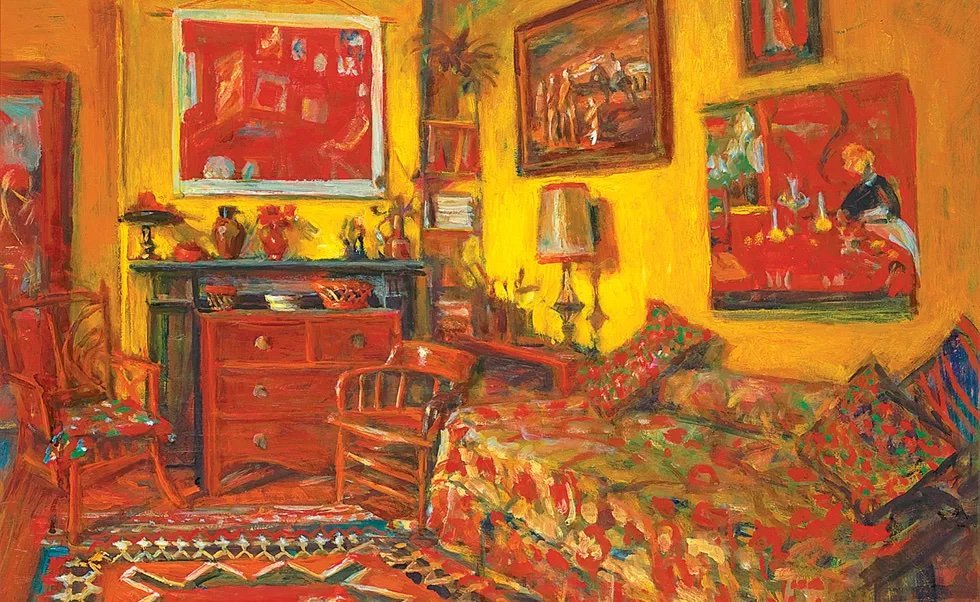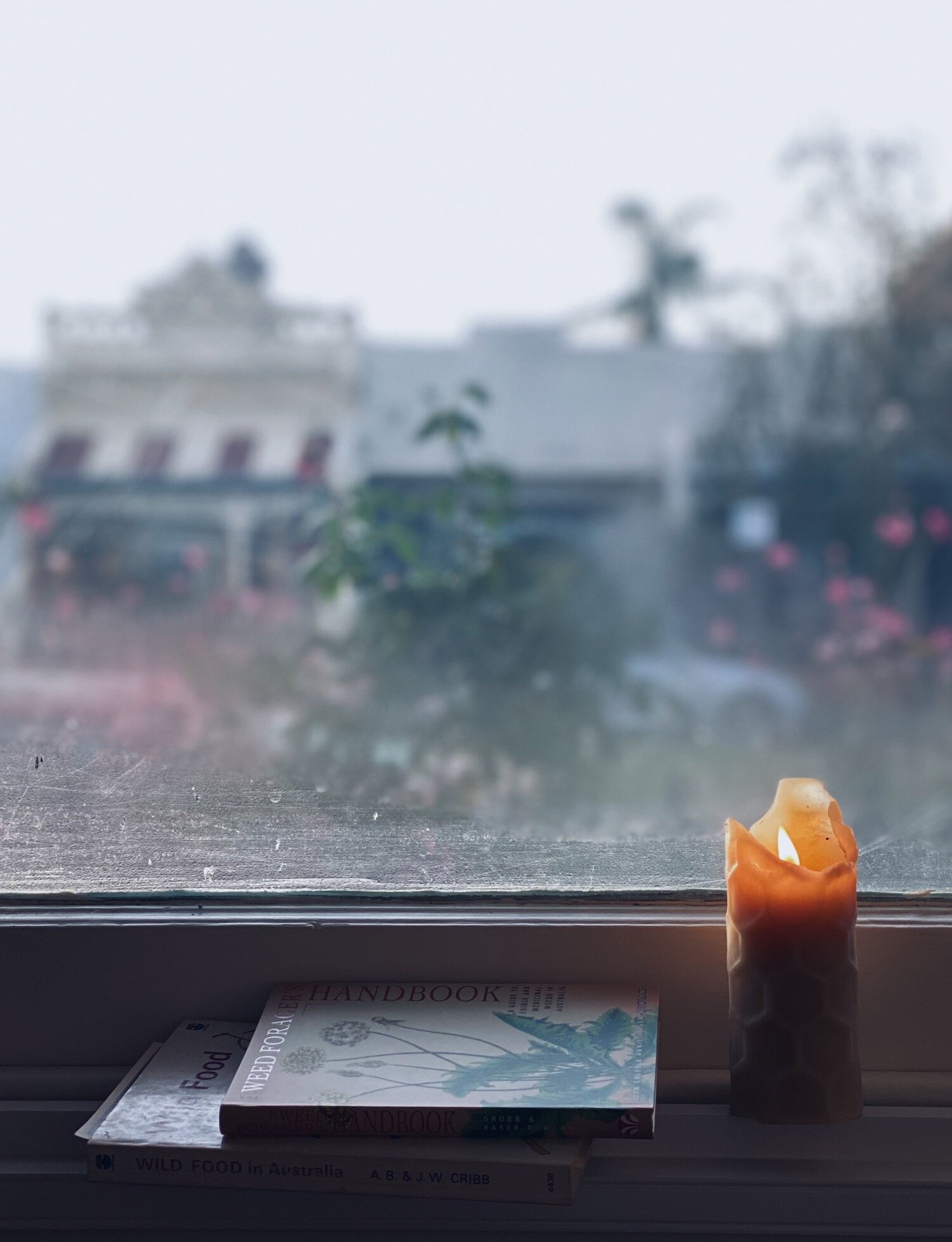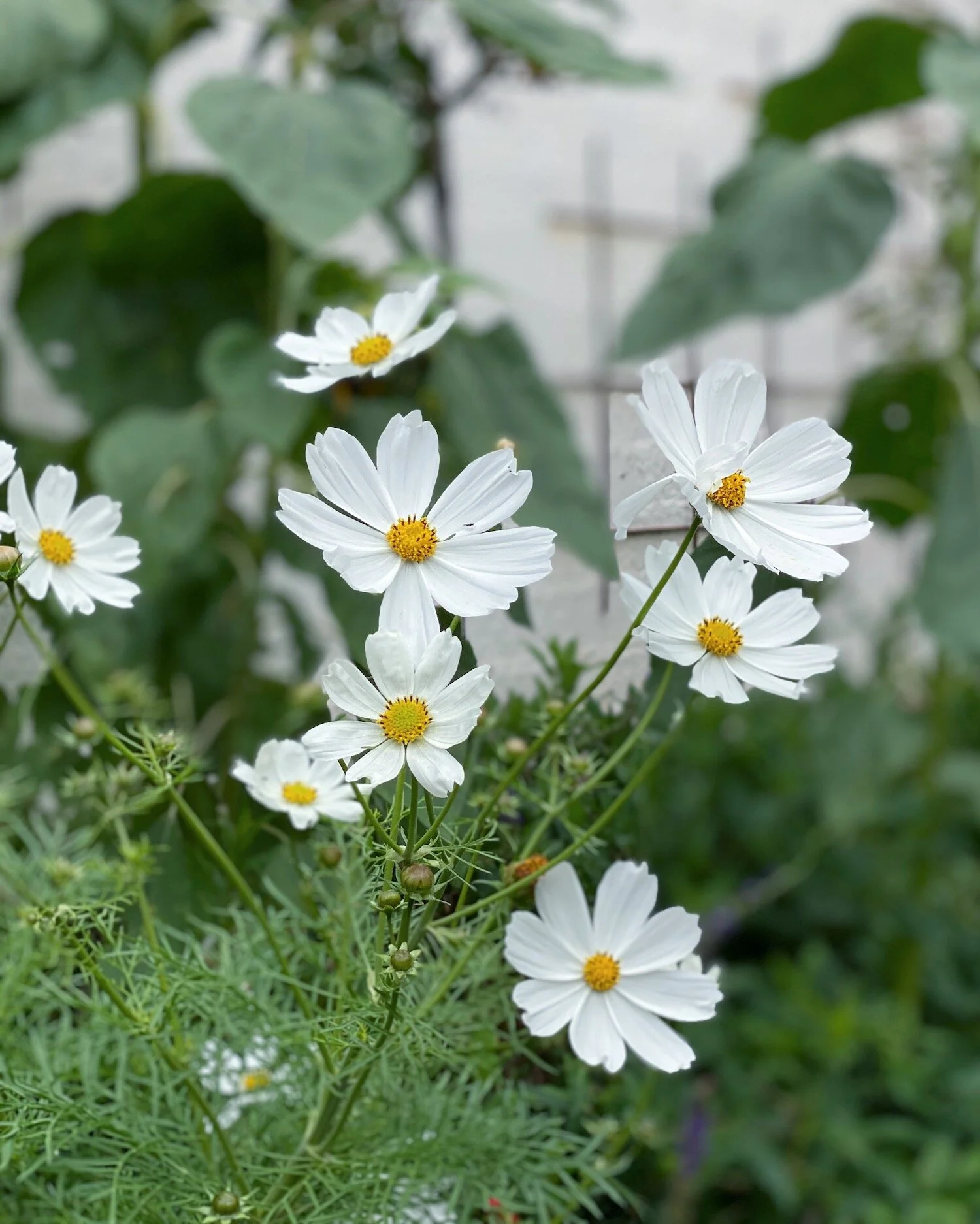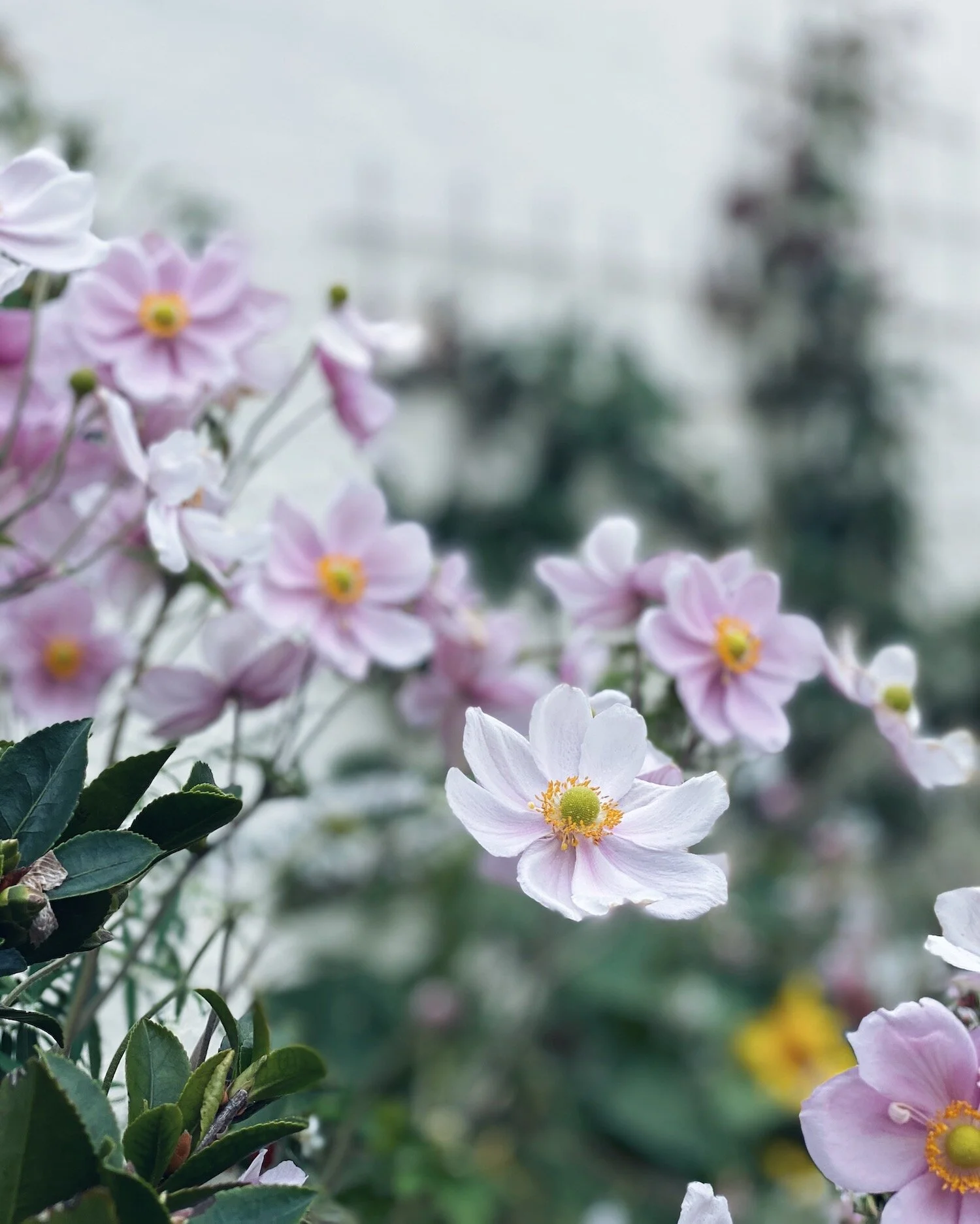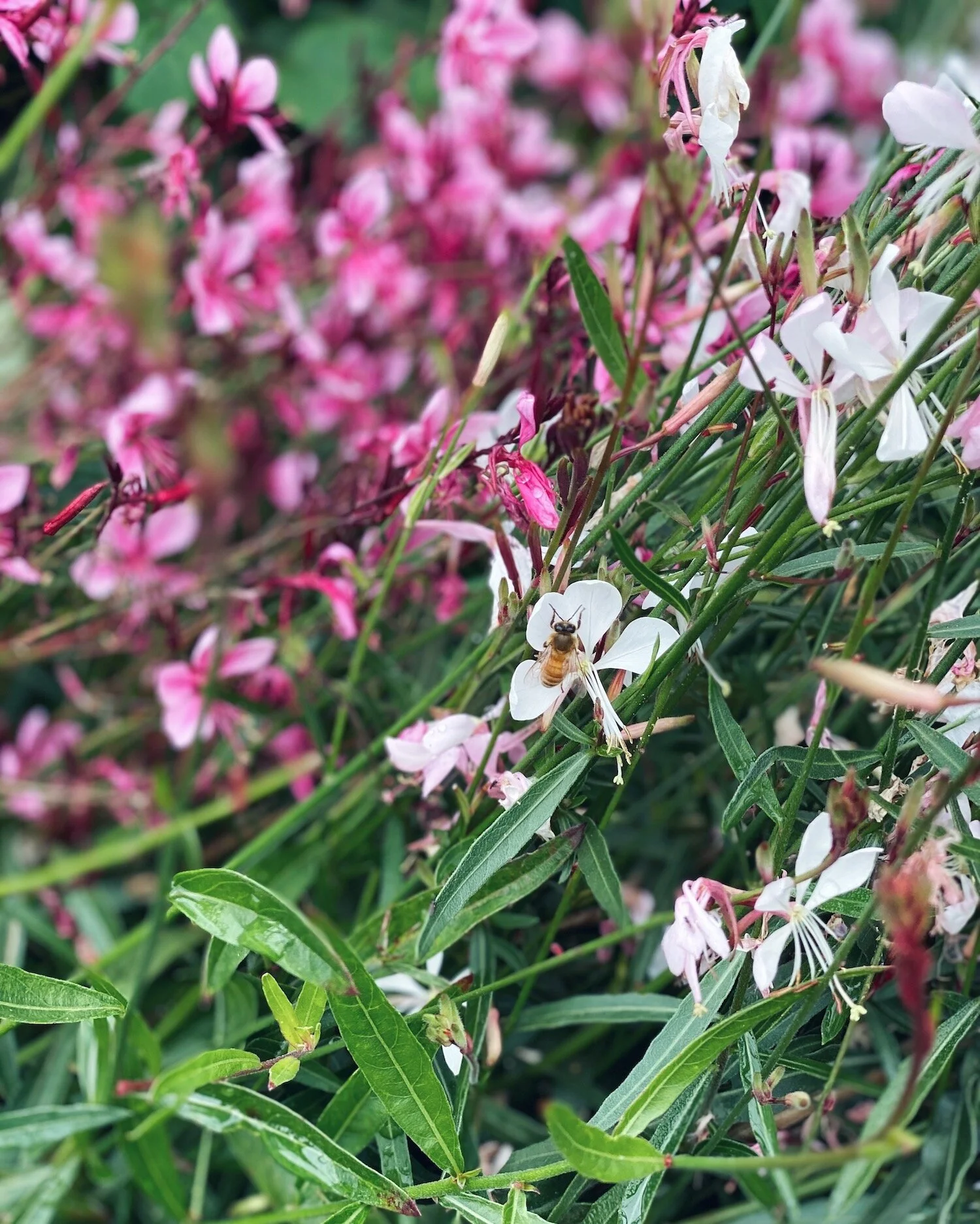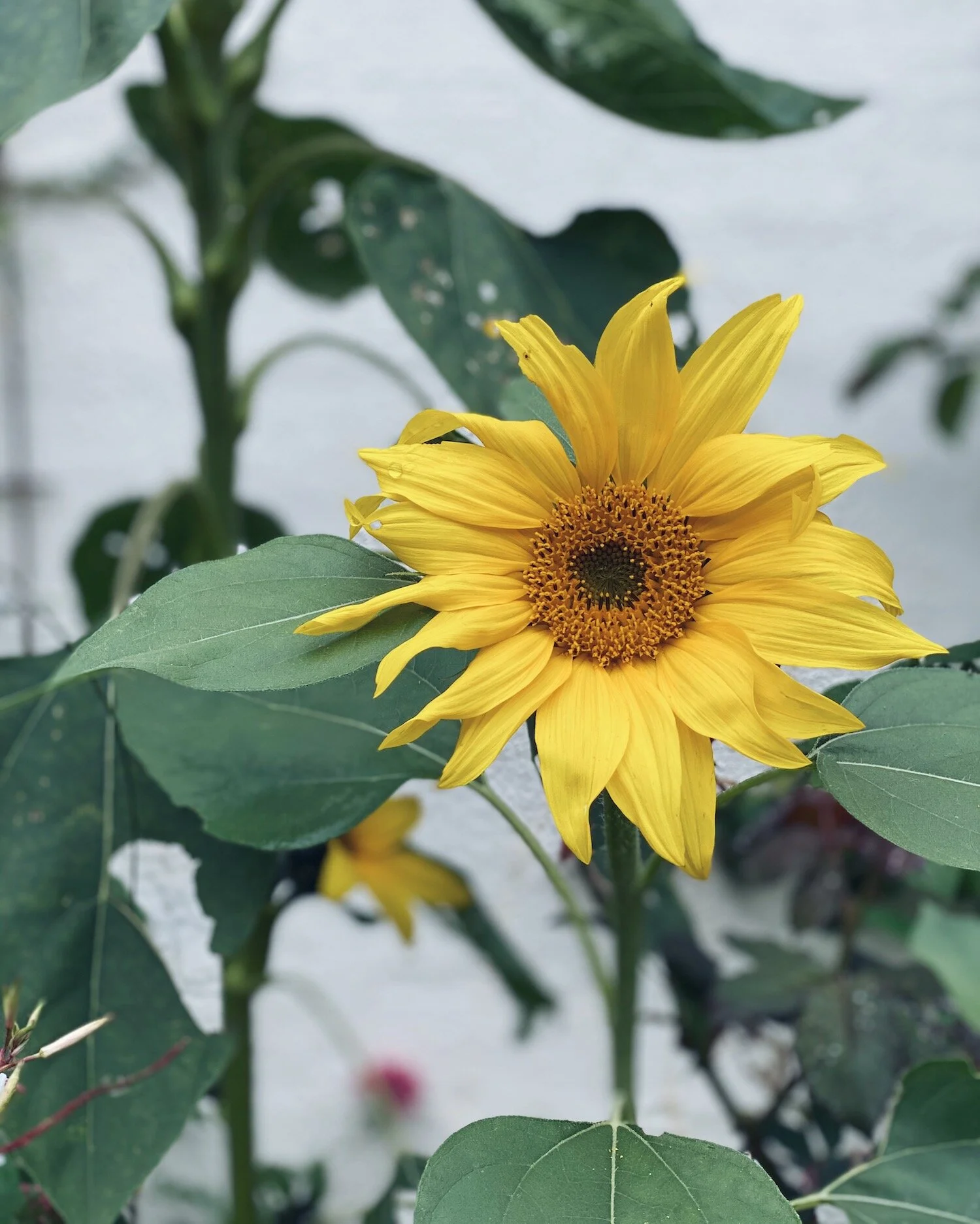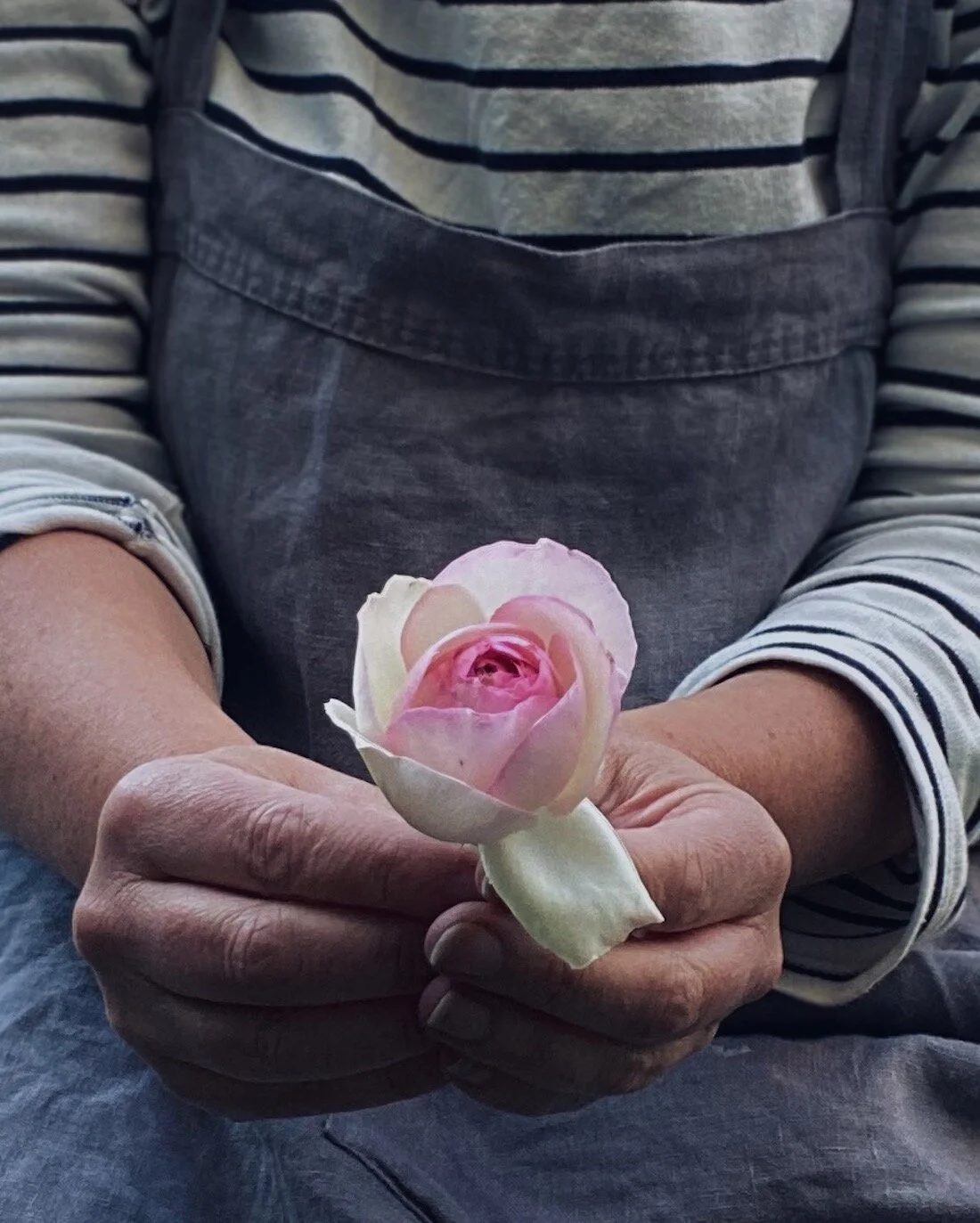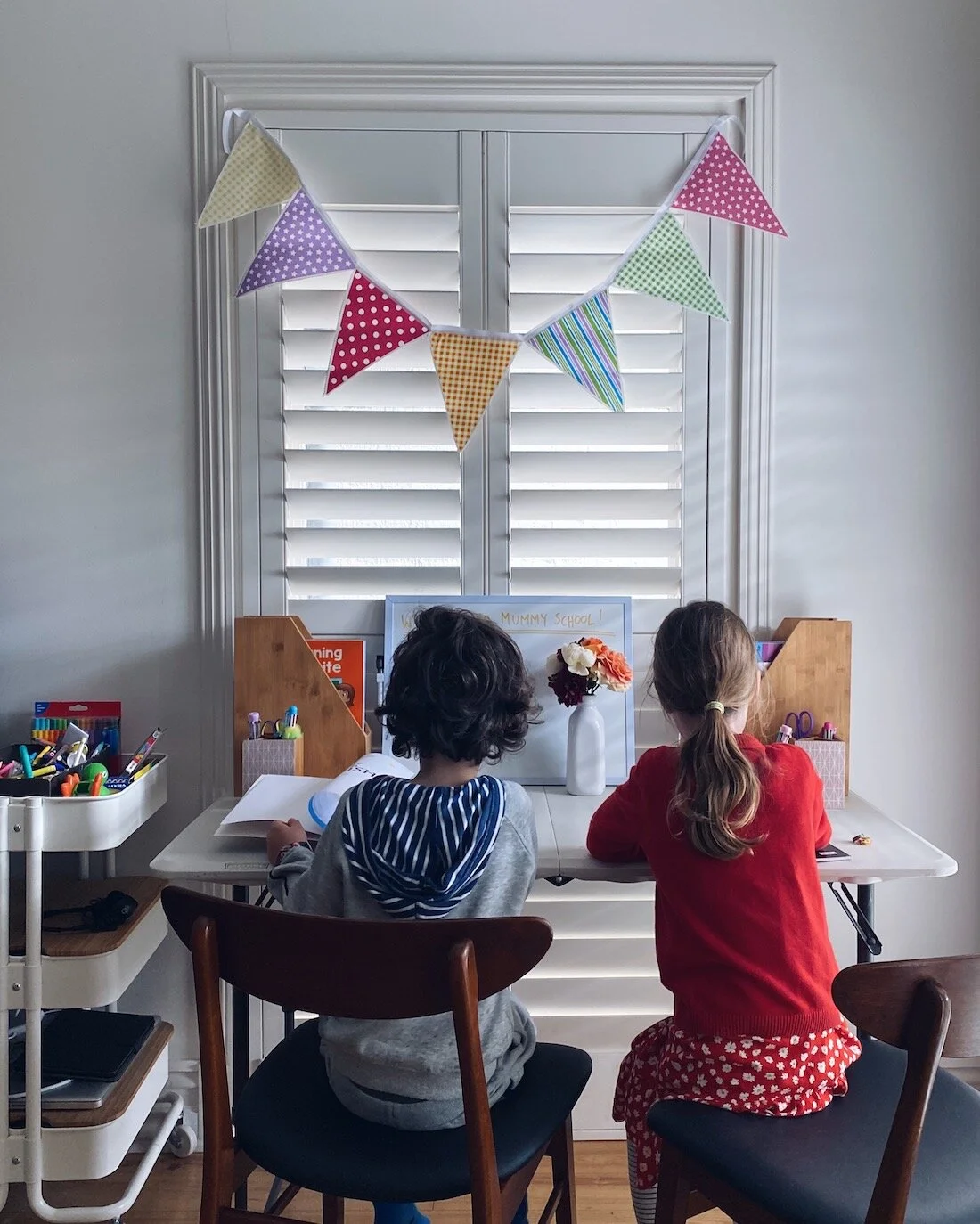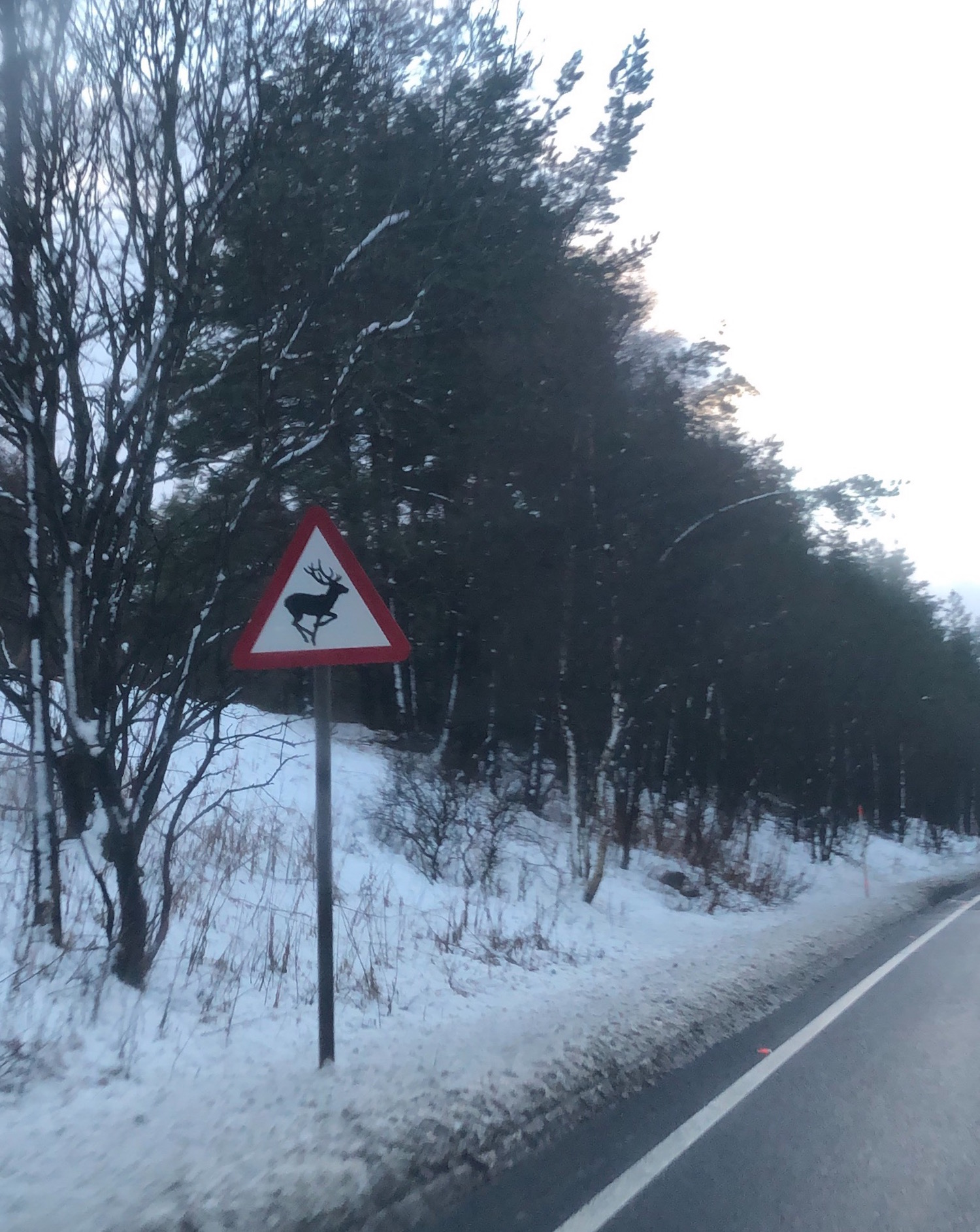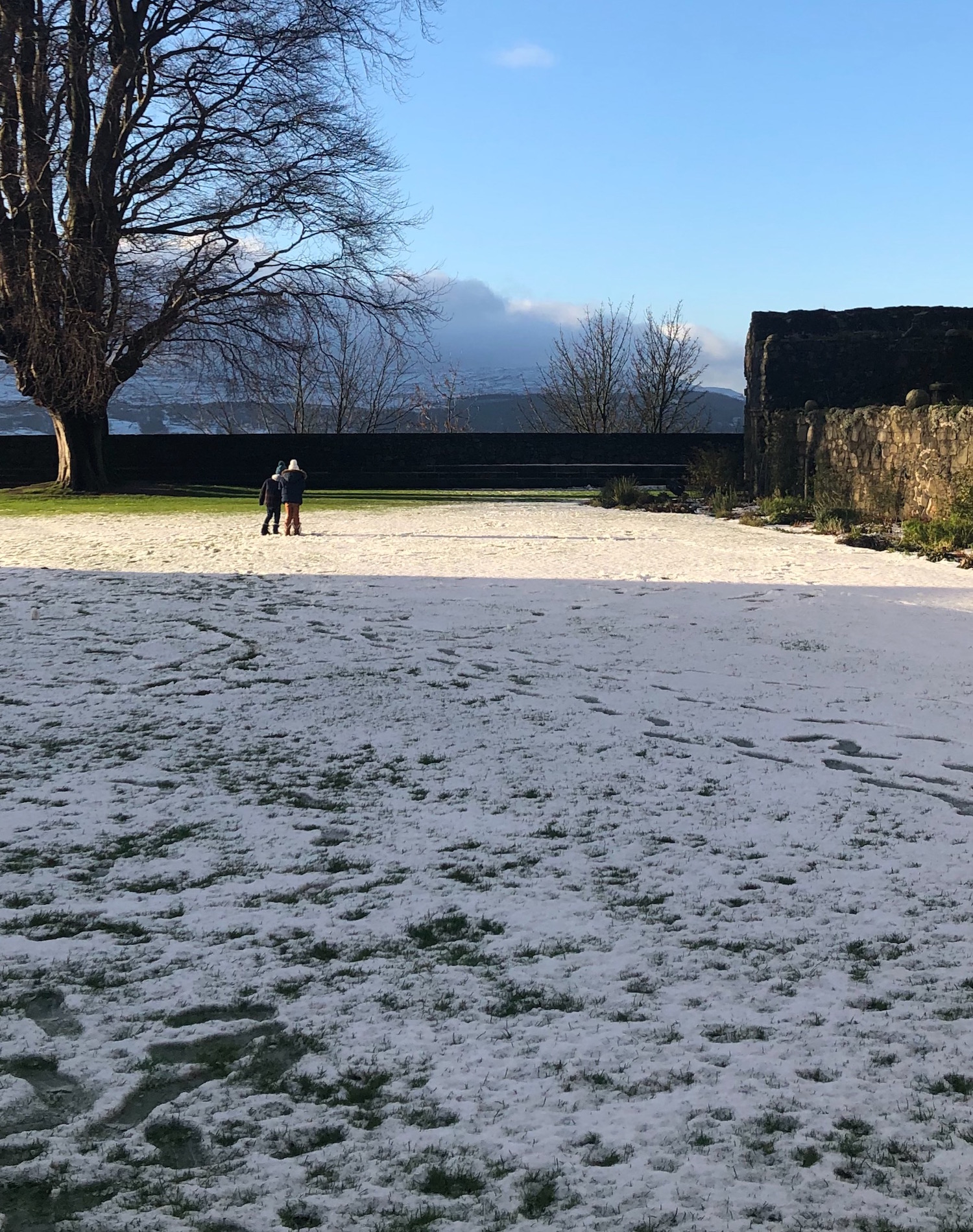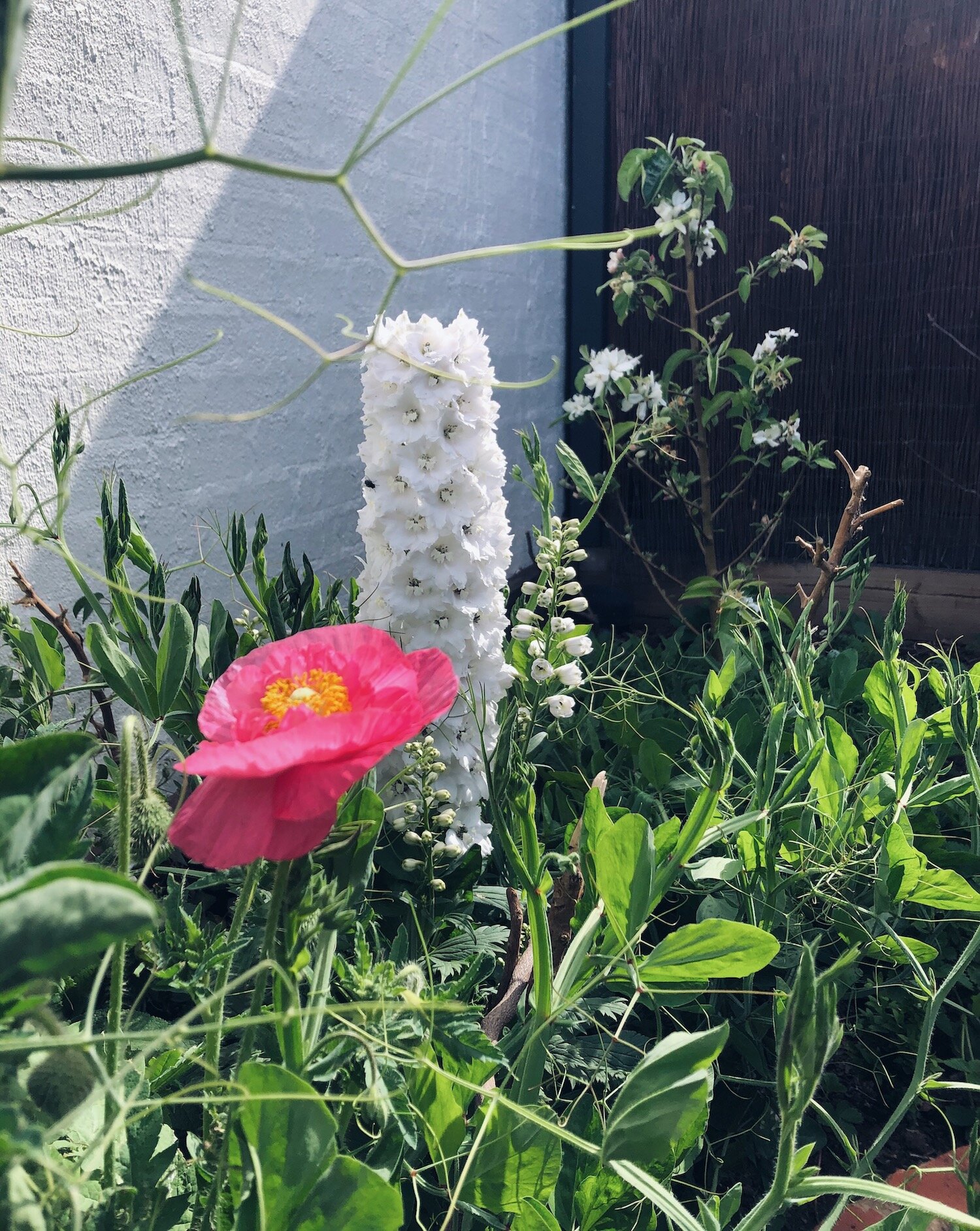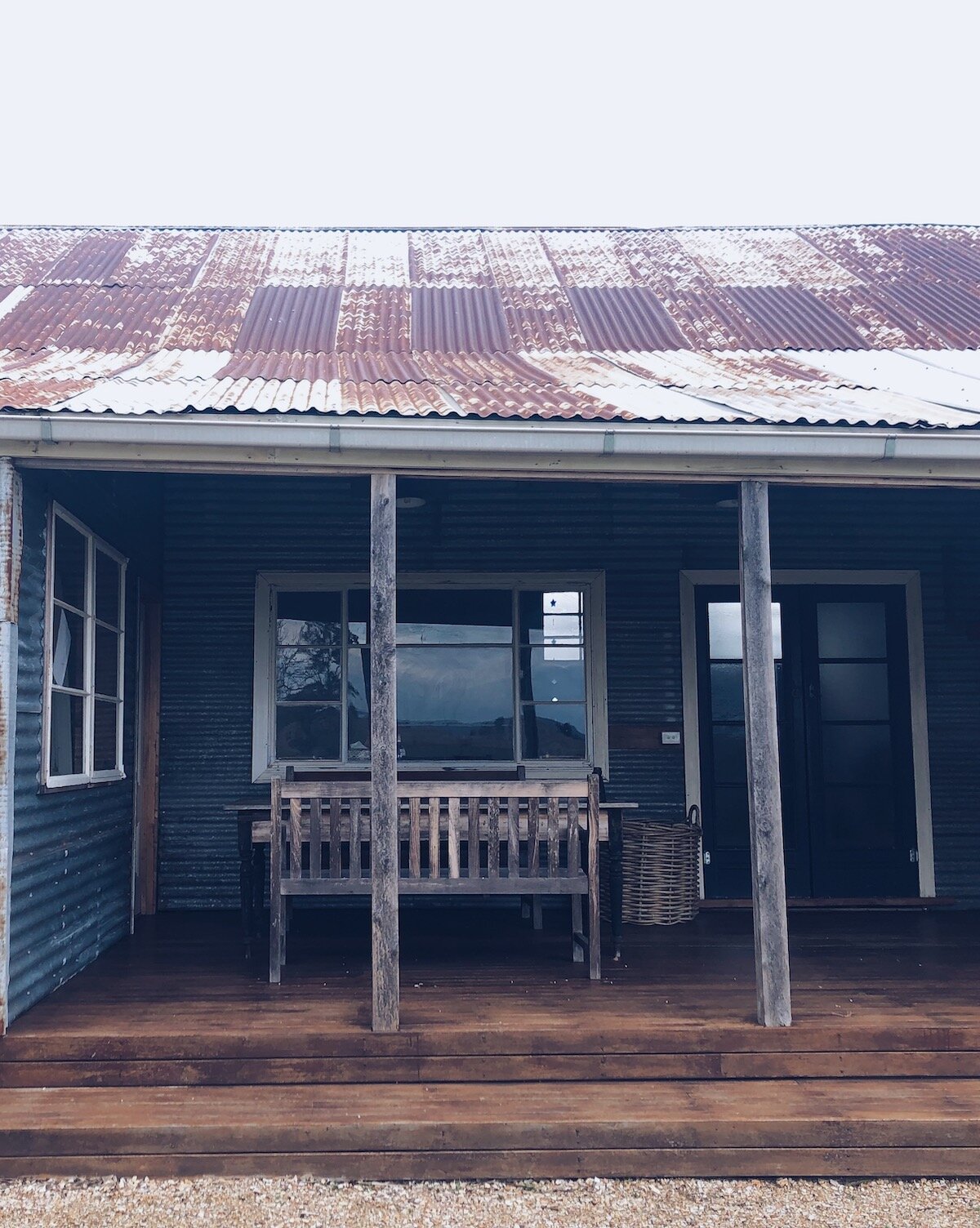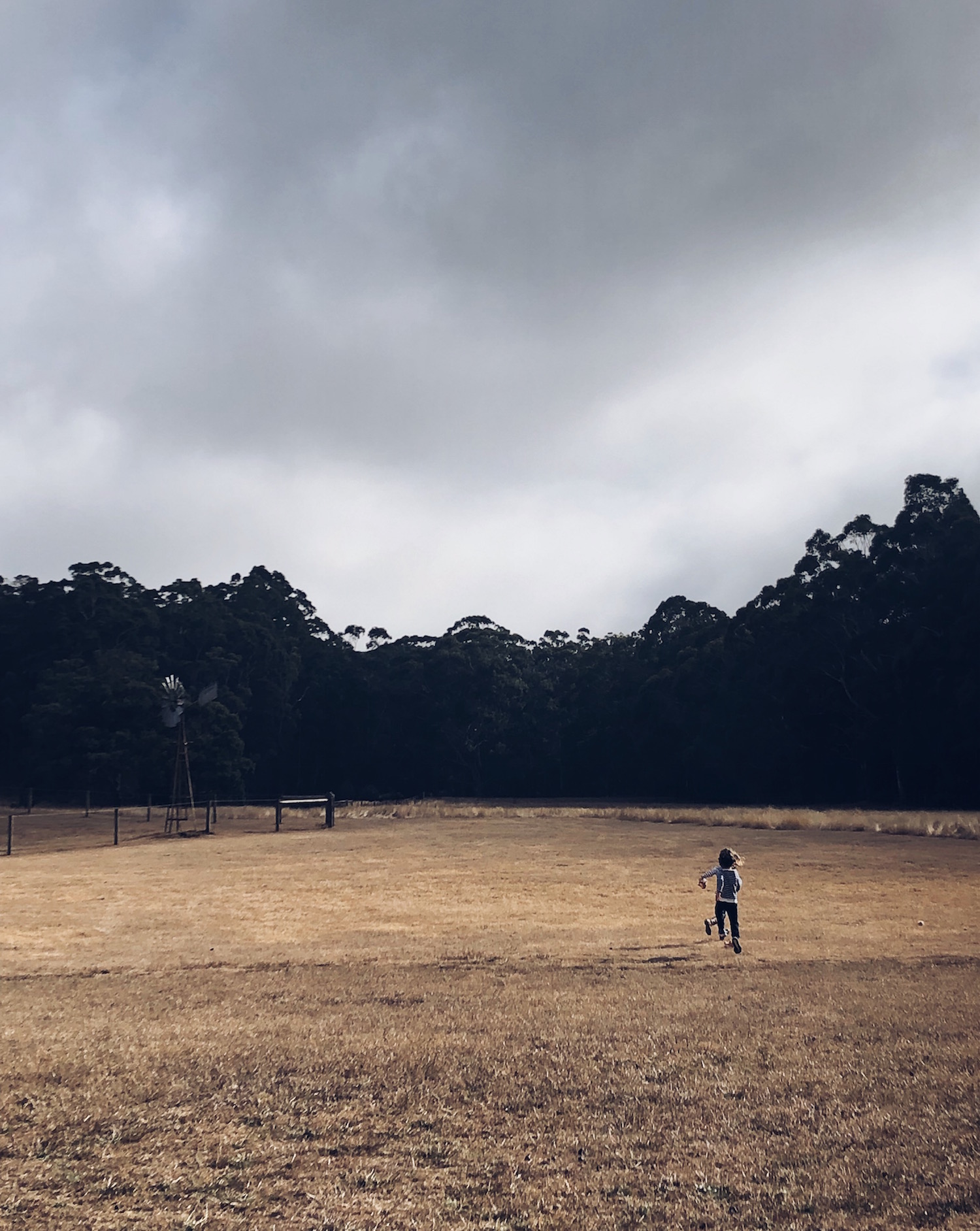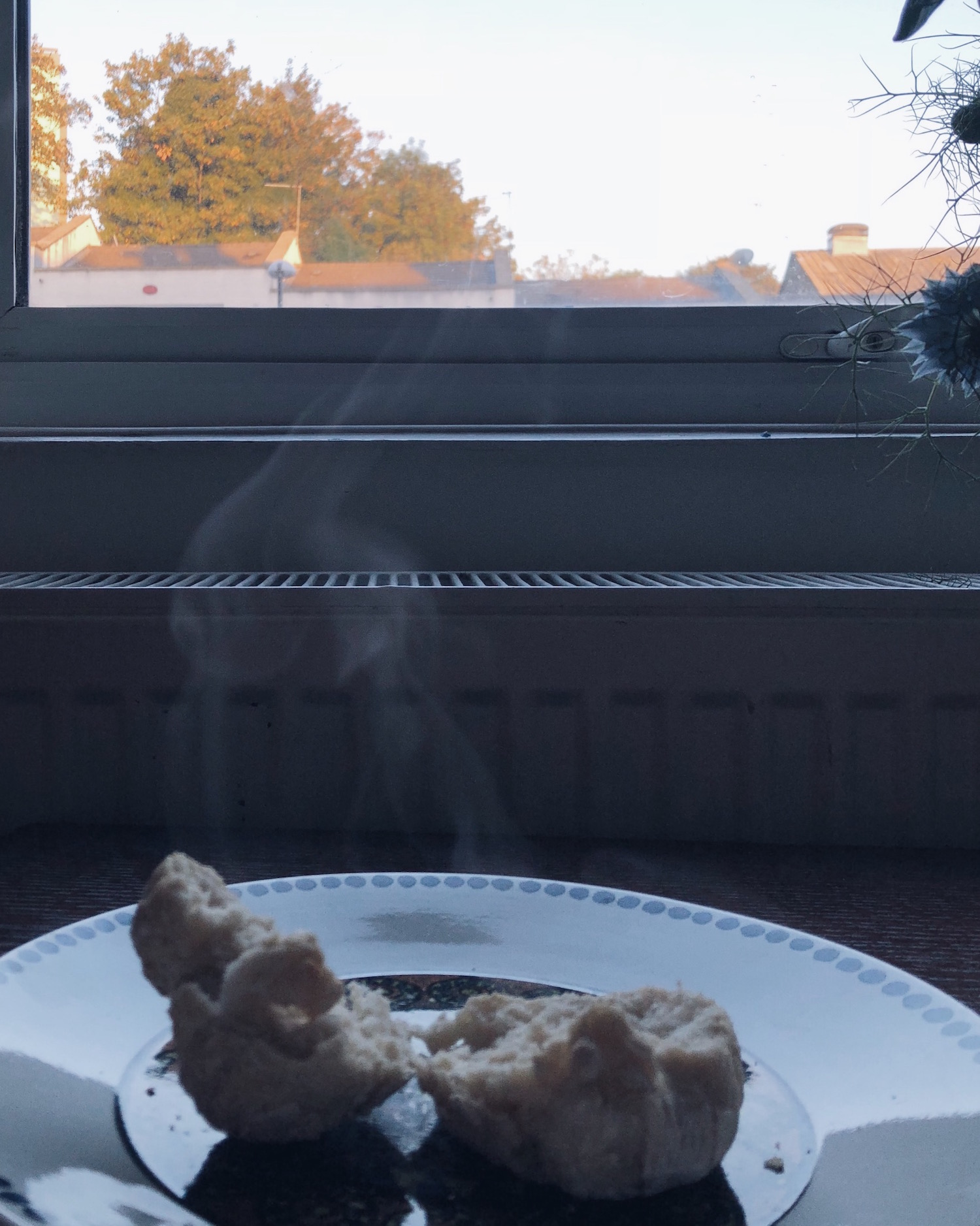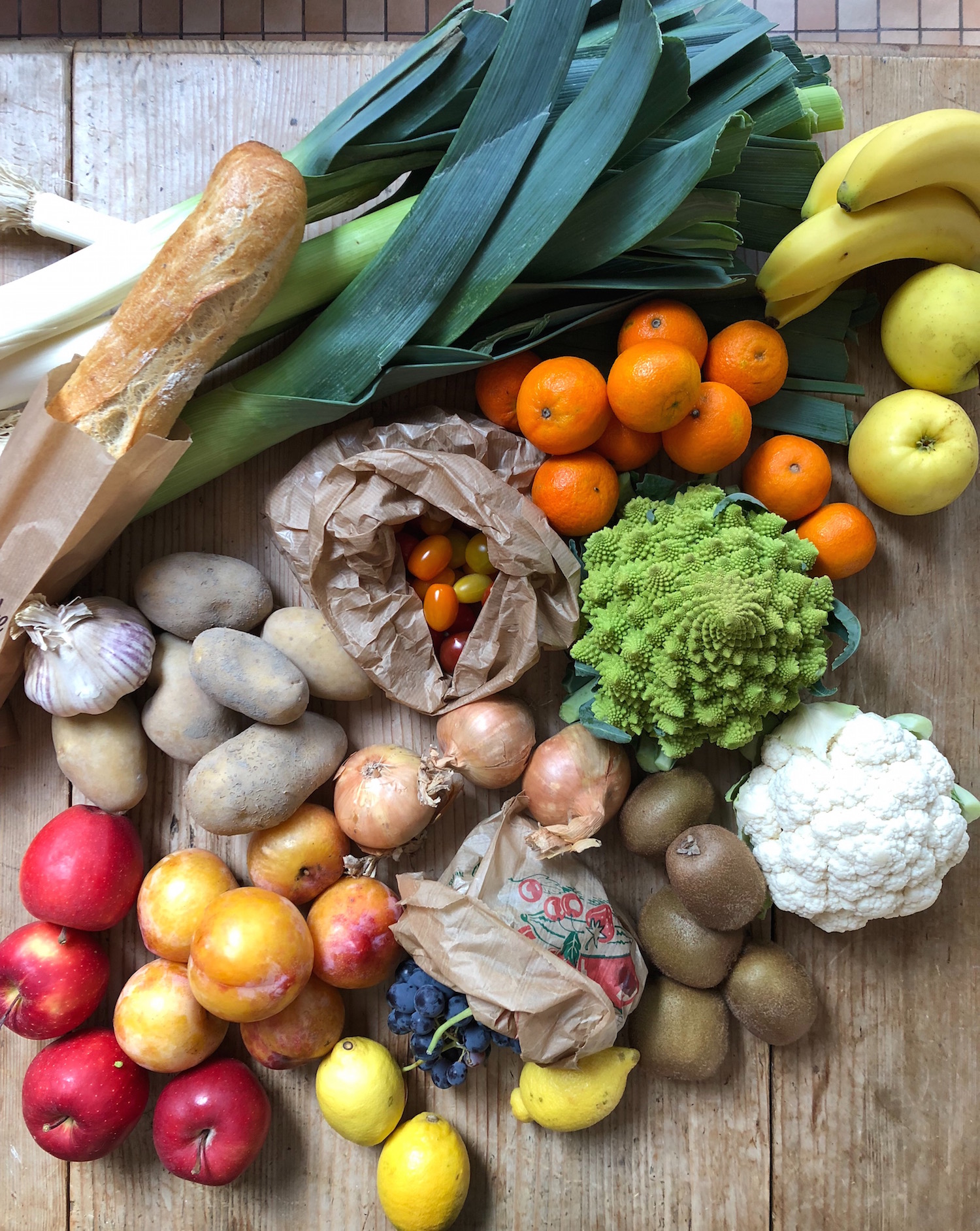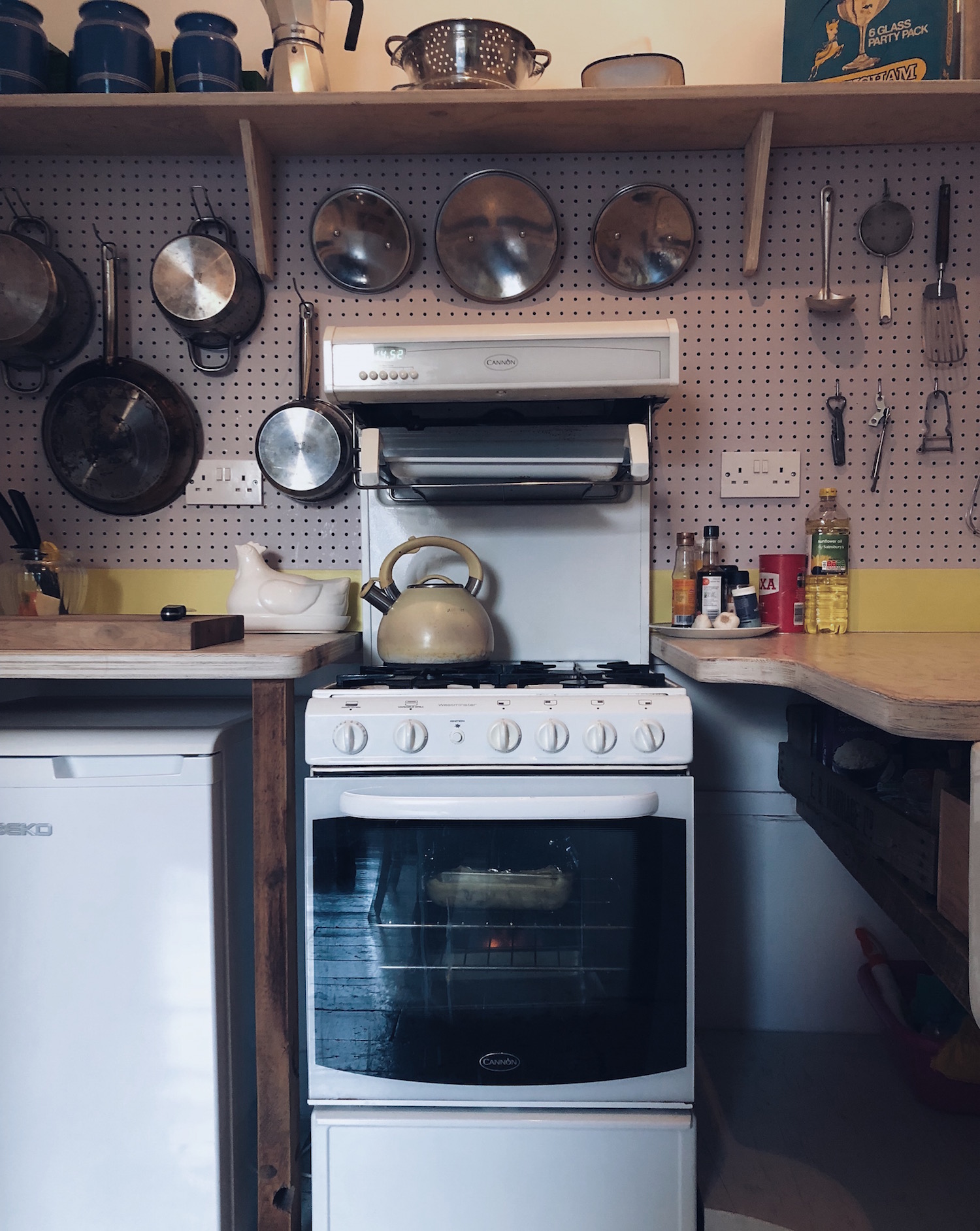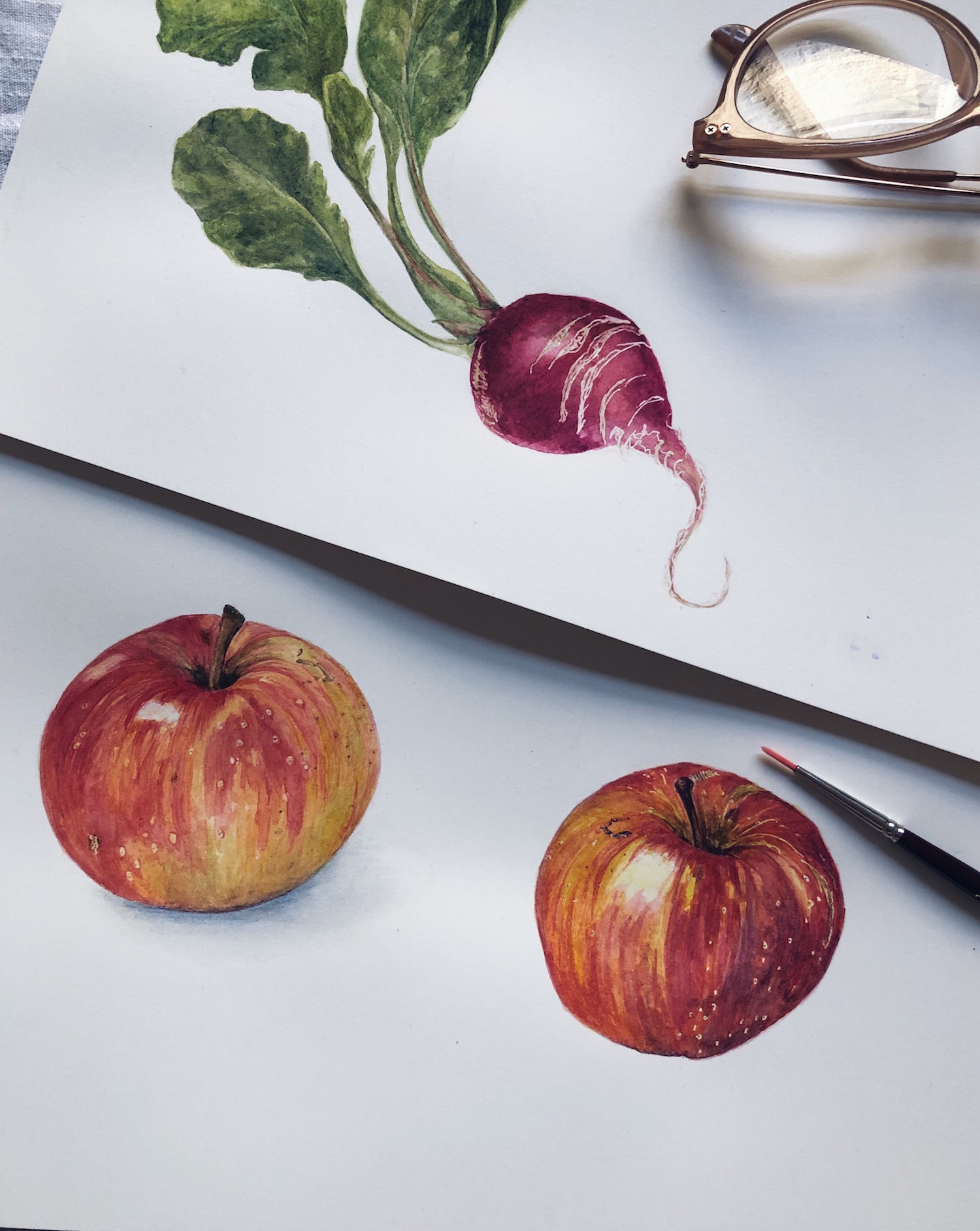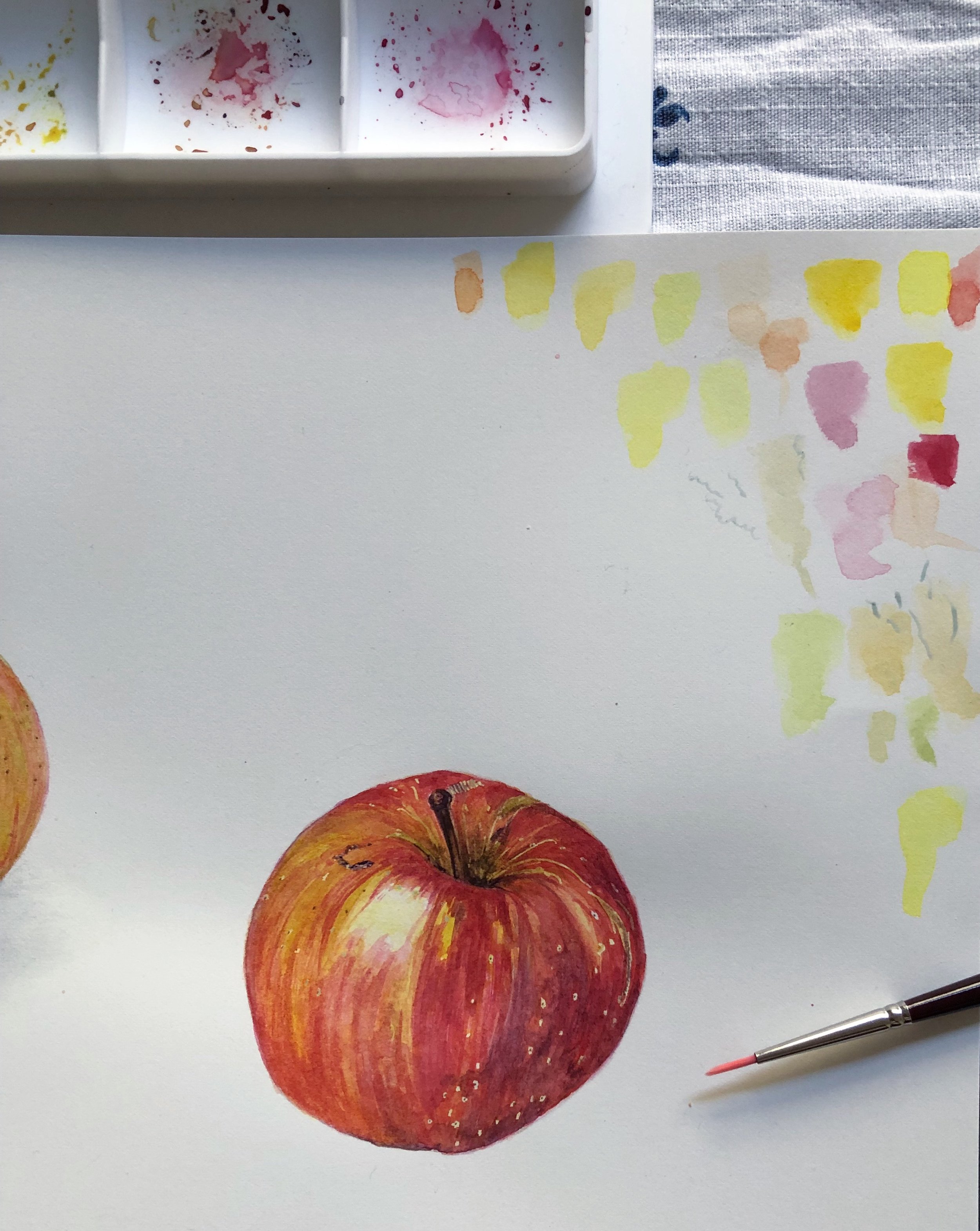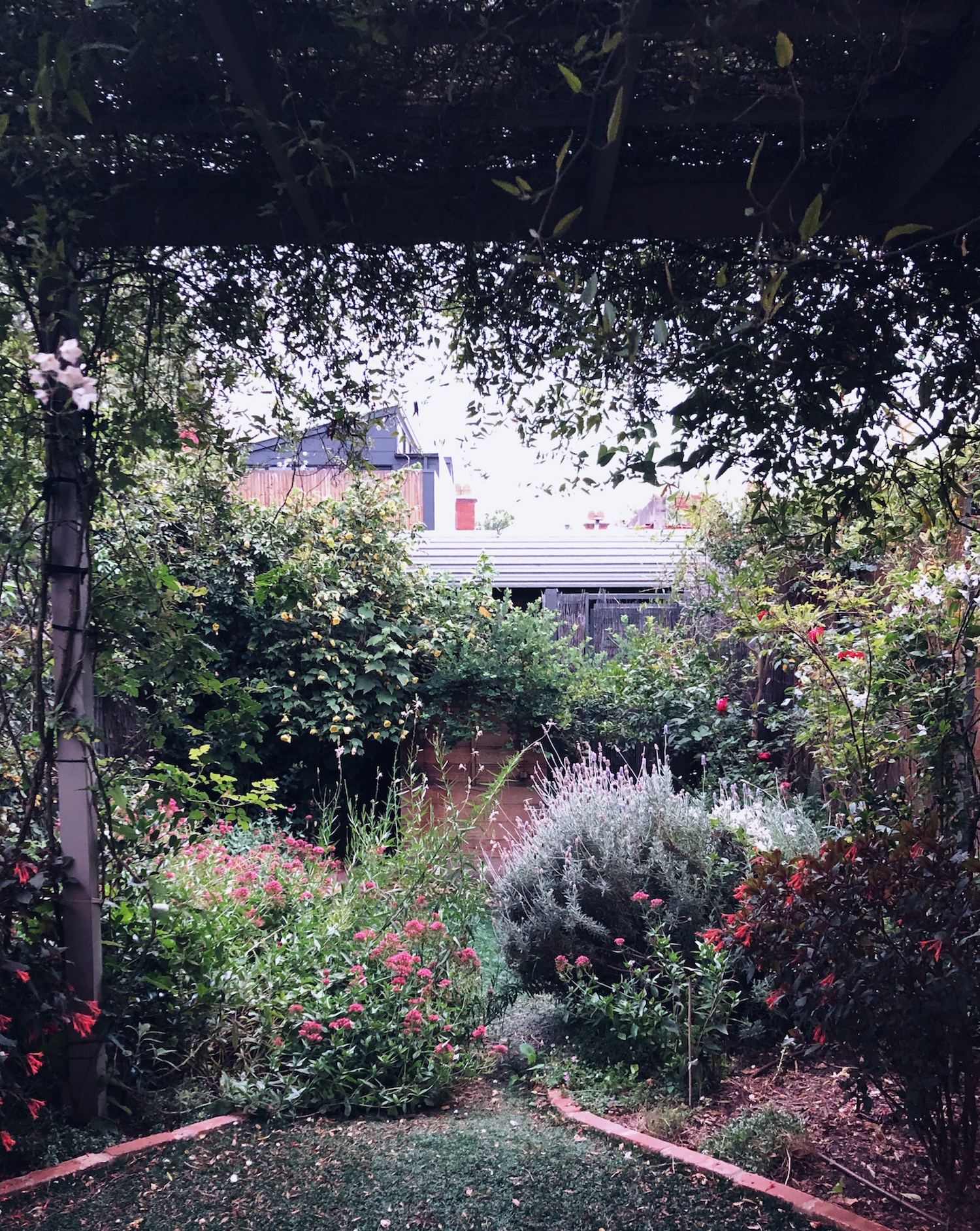
JOURNAL
documenting
&
discovering joyful things
Calm in the chaos
Margaret Olley, Yellow Interior (1989)
There’s a certain mental freedom - so powerful it almost feels like a physical freedom - to having an ordered home.
I see people - sometimes I go to their houses, I read about them, I see them depicted on TV - who live in creative chaos. Family members, friends, neighbours, pets, art, food, and all the trappings of a life lived in abundance race and chatter and laugh and love from room to room in their homes, leaving behind them a trail of noise and joy and the rough and tumble of life lived in utter creativity and spontaneity.
How do they do it? What secrets do they hold, that open the doors to creativity from chaos?
Have you ever had a glimpse of the late artist Margaret Olley’s house? I’ve seen photographs, and of course, she painted a lot of interiors, and it’s an absolute, fabulous, mess! There’s stuff everywhere. I’m not going to deny her home is wonderful to look at: the rooms almost feel alive, as though she was just - only a second ago! - there beside the window. And all over the tables, chairs, sideboards, floors and walls are all the wonderful, colourful, intimate detritus of life that made her paintings so alive and so special.
A recreation of a room in Margaret Olley’s house
Margaret Olley’s dining room (2011)
I can’t do it. For me, productive creativity comes from a place of calm. Of emptiness, even. Of quiet, and stillness, and the absence of clutter.
Of course, I’ve had to learn to compromise. We have children, pets, jobs, and are planning our renovation: our home is most often busy and cluttered, and my deadlines don’t stop just because the house is a mess. But when it is clean - oh! - it’s as though a burden I hadn’t known I was carrying has been lifted from my shoulders.
Is any of this familiar to you? Am I alone?
And when life itself begins to crowd in, to feel cluttered and chaotic and out of control, for me, that’s when the cleaning starts. My children have become wary of a certain look I get in my eye, and everyone metaphorically (or perhaps physically) takes an uneasy step backwards. “Oh no, she’s got her Cleaning Face on again.” It’s a kind of instinctive reaction I have to feeling out of control: what’s one thing I can control? The way the cereal boxes line up in the pantry, that’s what.
Well, life is feeling more than a little chaotic right now. We are hurtling towards the end of the year at breakneck speed: I’m in the final weeks of teaching Let it Grow, my Tangle & Fern clients are busy needing Christmas sales content and trying to wind up projects we’ve been working on, Meals in the Mail is snowballing with joyful abandon, the children’s school seems to have a new excursion/concert/fete/fundraiser on every second day, and I’m fairly sure that all the social and professional engagements that were cancelled during the past two-and-a-half years have all been crammed into the three months from October to December this year.
Margaret Olley, The Blue Kitchen (1993)
And at precisely five o’clock yesterday afternoon, it all became too much.
I closed my computer, went into the kitchen, and started pulling things out of the ‘fridge and putting them onto the kitchen bench. And I didn’t stop until quarter-to-one in the morning. By the time I finally climbed into bed, the ‘fridge was gleaming, the food neatly sorted and stored, and our pantry (which previously resembled Monica’s secret closet) was ordered to within an inch of its life.
The thing about our pantry is that it’s built like a tall, shallow wardrobe. Utterly impractical. Several of the shelves are above my eye-line, and can’t even be reached at the back by my blind, groping hand as I try to figure out what’s in there. (The kitchen renovation starts in February).
My husband definitely does not help the pantry situation. For some unfathomable reason, he loves to visit the supermarket, and shops as though we are hosting the Under 15s football team daily (as opposed to the reality, which is two adults who eat out too often, and two small and somewhat picky children). This, despite the fact that he doesn’t actually cook.
Every weekend I beg him not to go shopping, and every Saturday he heads to the supermarket and returns home laden with bulging shopping bags, saying, “It’s just a few essentials.”
Last night, as I tidied and sorted into the wee hours, I found in that pantry:
15.92kg of sugar, in various colours and forms
5 packets of panko breadcrumbs
2kg pearl couscous
5 boxes of powdered cocoa
6 boxes of muesli bars (mostly the ones the kids won’t eat)
407 Twinings English Breakfast teabags
(I mean, he wasn’t entirely over-reaching with the teabags).
And when I got up this morning, despite definitely not having had enough sleep, I felt freer. I kept opening the ‘fridge and pantry just to look at all that lovely order, and it made me smile. I felt so free, so calm, I was even inspired to start writing again, and to dust off this friendly old blog.
Hit me with your best shot, Silly Season. I’m ready.
Stories of a house
Do you remember the house in the Pixar movie Up? And the way love and happiness and big dreams (and sometimes even sorrow) filled that house for many, many years, soaked into its walls, and made it a home, so profoundly so that the old man refused to give it up, no matter the personal cost?
My house looks a little bit like that house: it’s more than 100 years old with a big sash-window at the front resting on a bluestone sill, patterned bricks, a shingle roof, and a sweet chimney right in the middle. There’s a coloured window over the front door - a door we painted bright red because the colour brings us joy - iron lacework over the verandah, and a chair that we like to sit on in the evenings to watch the goings-on in our pretty street*.
After 12 years, two babies and a lot of laughter, my house feels a bit like the Up-house, too.
But now we are leaving it. It’s time for our family to move on to new places - up, up and away, just like the movie, except that unlike the grumpy old man in Up, we can’t bring our beloved house with us. And even though I know it is the right decision for my family, it is still breaking my heart a little bit.
Don’t be fooled by the white paint: the walls of this house are thick with stories, like layer upon layer of beautiful wallpaper. A hundred years of families have lived and loved in here, and I think you can feel them.
We read a story on the internet once - I wish I could find it to link to it now - of two sons who once lived in this house, leaving it to join the fight in the Great War. We imagined them opening the front gate (the very same front gate that we still walk through now - did it creak then, too, I wonder?) and striding down Canning Street - even back then a beautiful boulevard with Victorian-era palm trees - and out into the terrible turmoil of war. We imagined their mother, lump in throat, waving from the window of the same sunny front bedroom that I now use as my office and art studio.
Only one son returned.
Here’s another story of the house:
Once upon a time a man and a woman fell in love from opposite sides of the world. The woman lived in New York while the man lived in Australia, and together, they decided to buy a house. The man found somewhere suitable in Melbourne, a city the woman had only ever visited twice, and only briefly. The woman agreed to give all the money she had inherited from her grandmother to her new boyfriend, to pay the deposit on a house she’d never seen, in a city she barely knew.
It was crazy and all her friends told her it was crazy and you know who I’m talking about, don’t you.
I still remember the auction to buy that house. It was Saturday morning in Melbourne, which meant it was Friday night in New York, humid and just growing dark. I’d been out at a wine bar with a friend but I jumped in a taxi and raced home early so I could listen to the action on my ‘phone. My stomach was churning with nerves and excitement. That was all my savings. The money I’d planned to use to buy a studio apartment in New York, and I was trusting it to someone I’d known for the shortest of times, tying me back to Australia.
The auction was a moment of profound trust - trust in the man I’d so quickly fallen in love with, and trust in my own instincts (which, thankfully, proved well-founded). So the house became a symbol of our love, and my faith in our love.
This was the house where we finally created a home, after six international and interstate moves in 18 months.
It was the home we brought baby Ralph into, and Scout was so small when we came here that she doesn’t remember anywhere else. We gave them the sunniest bedroom just off the master, with city views over rooftops, that - in our pre-kid days - we had imagined would become a reading-and-painting room.
The dining table beside the big, arched window has hosted countless meals with beloved friends, lunches that have turned into dinners and the roar of laughter that has echoed late into the night.
We’ve had rousing sing-alongs around the piano in the family room, camped out on blow-up mattresses in front of the open fire in the lounge room, started a book club, run a small business, managed to blow up the microwave on Christmas Eve one year, then managed to blow up the oven on Christmas Eve on another year (whoever moves here next will be the happy recipient of my new, self-cleaning oven, lucky them!), and no matter how hard life has been from time to time, I don’t think a day has gone by without laughter.
The garden (sleeping now for winter but always bountiful in spring and summer) became a loving respite during lockdown last year, a secret, walled garden filled with roses, apple trees, Japanese maples, hydrangeas, and a pomegranate - as well as foxgloves, cosmos, gaura, poppies, clematis and nigella in summer; where we could lie in the sun and feel part of the earth outside. On sunny, pre-covid days, the garden was the scene of spring parties, impromptu picnics, and one time, a fully-fledged Christmas concert.
And now we are saying goodbye to this house, where we have been so very happy. I truly believe that the next people who live here will feel a little something of that happiness, because we all know bricks retain heat, and I hope that joy will filter into their own lives, too. It will be a happy place for them to live, don’t you think?
So the stories of this house will continue and even though they won’t be our stories to tell, any more, our family still has a place somewhere in the fabric that tale. Or at least I hope so.
* Canning Street is divided by a big median-strip of grass through the middle, dotted with palm and poplar trees that were planted almost a hundred years ago. It’s the most wonderful place for community to happen. Here are some of the things we’ve watched, while sitting on the bench on our front verandah:
- picnics
- yard sales
- formal dinner parties
- an inflatable swimming pool
- a man practising how to cast a fishing line
- movie nights (with bedsheets for screens)
- table tennis
- and even once, a big brass band
ps. The photographs on this blog post (other than the summer garden and Scout floating up and away) are from the official listing for our house, which you can see here if you’re curious like me and like to sticky-beak into other people’s houses (or if you happen to know someone LOVELY who wants to buy a much-loved house on Canning Street).
Wins and losses and taking stock
The ebbs and flows of life in lockdown.
Win: this week Scout discovered the joys of Harry Potter. She is nose-deep in Harry Potter and the Philosopher’s Stone, and each morning when she comes downstairs after reading, we talk about what has been happening inside the pages. Sharing a book I love with her is like travelling together. We may not be able to leave the neighbourhood but together, we travel to Number 4 Privet Drive, to Diagon Alley, and to Hogwarts, every morning.
Loss: school at home. Don’t even get me started! I don’t think I’ve ever felt the kind of anxiety I experienced during that first week of school. The teachers are doing the most amazing job creating learning content for the children, and I’m incredibly grateful. Let’s just say there is a disconnect between the school’s expectations and communications, versus our access to technology, devices, my time, and the children’s capacity to independently follow instructions and use technology they have never seen before.
Win: last Thursday we ditched school for most of the day (with permission) and spent several hours baking hot cross buns via Zoom with private cook Gillian Bell, otherwise known as @gillianbellcake on Instagram, and one half of the delightful Dispatch to a Friend podcast. Gillian gave up a good part of her day to bake with us, and I can’t decide whether the best part was the proud smile on Scout’s face when we pulled those wonky-but-perfectly-cooked buns out of the oven, or the joy of spending time with Gillian and chatting with her about everything from yeast-bubbles to mental health and post-war life in London. I’d like to do this again soon, please.
Loss: scared and angry people in the street looking at my children as though they are predatory germ-terrorists every time we have to leave the house to get food or exercise. We follow the rules. We stay out of the way. They huddle in sad corners outside the grocery store following my instructions to stay out of the way, not move or touch anything, while I race in and buy the basic staples I can’t get online. They dive into bushes to escape cyclists who race past without slowing or swerving on the shared foot-and-bike path. And they endure angry looks, snide comments, and, occasionally, openly hostile “Get out of the way!” shouts from older adults if we happen to be on the footpath while someone wants to walk towards us.
Win: I got all the bulbs that our friends Pam and Kaylene gave me into our garden, I’ve trimmed back the gaura that was going wild at the front of our house, the roses are having a bumper autumn, and whenever the weather is warm we take ourselves out into our tiny garden for fresh air, snatches of sky, and growing things. Never have I been more grateful that I turned our tiny car-park into a garden than I am now, during these funny, self-isolated days.
Loss: the possums are loving my garden too. I mean really loving it. They particularly love the roses, the pomegranate tree, and one of the apple trees. I’ve tried sonic deterrent. I’ve tried possum spray. I’ve tried netting. I don’t know what else to do!
Win: last weekend I hosted my Signature Scent branding workshop online, an adaptation of the workshop I’d hoped to host in my home. I was very nervous about how it would all work out, but could not possibly have dreamed up a better group of women to join me for this. They were - one and all - intelligent, creative, fun, kind, enthusiastic, and enormously patient with me and the technology. I entered it full of nerves and came out on an absolute high, almost entirely because they were just such good company!
Loss: angry emails. I guess everyone is feeling anxious and stressed. A customer of one of my clients got the wrong end of the stick and in his anger, he lashed out at both my client and me. It was one of those situations where you can tell yourself it isn’t personal, you can tell yourself that these people have their own problems and their own issues going on in their own lives… but it still hurts. It can still cause sleepless nights here and there, and reignite insecurities old and new. Let’s not forget our compassion in all this mess, nor that the person on the other end of a complaints form is a real person too.
Win: knee-deep drifts of autumn leaves and alllllll the joyful games.
Loss: it plays on you doesn’t it, the isolation. Loneliness; feelings of claustrophobia; angry neighbours and online meanies; constant, low-level anxiety. Turns out resilience isn’t in never-ending supply without careful nurture, and I find my own capacity to cope ebbs and flows each day (and several times within a given day). Are you experiencing the same?
Win: we are healthy, and so are our loved-ones. I don’t underestimate how truly lucky we are.
Win (sort of): every year of his childhood, my husband’s family sat a stuffed Santa under the tree among the presents. It is a cherished memory of his and so, even though Santa’s stuffing was literally bursting out of his belly-seams, half his plastic face had caved in, and one boot was mysteriously missing, my husband held onto the doll. It was packed away in a box marked “nostalgia” that has moved with us from house to house and State to State for more than a decade. Over Easter Mr B cleaned out our shed (there was little else to do!) and in doing so, rediscovered Santa. He found a lady online who could restore the doll and this weekend, Santa was returned to us, almost as good as new. My husband is THRILLED. All day on Sunday (oh yes, the post came on Sunday!) he kept saying, “I’m so happy Santa is back. Kids, look at Santa!” (Although he did find Santa’s newly-smooth cheeks disorienting, and poked his finger into one side to restore the dent he remembered so well from those childhood years).
The reason this is only a “sort-of” win rather than an unambiguous win is because, frankly, Santa is TERRIFYING. He has blood-red wrinkles, a demonic grin on his face, and his eyes follow you around the room. It’s like having a Chucky doll leering at you from the mantlepiece.
Taking stock
Pip Lincolne of Meet Me at Mikes has been doing “taking stock” posts for years, and I thought I’d join in today with a version of my own. Do you want to do the same? Just copy and paste my list below, and replace my answers with your own. Be sure to let me know so I can come and see what you’ve been up to.
Making: beautiful brand style-guide brochures in InDesign for my workshop participants
Cooking: today I made a Sunday roast chicken using the recipe from Yotam Ottolengi’s book SIMPLE and it was seriously good! So far everything I’ve made from this wonderful cookbook has been a win
Sipping: tea, always tea. English Breakfast, rosehip, peppermint - these are my favourites
Reading: The Lost Future of Pepperharrow by Natascha Pulley. Also, the wonderful #dispatchfromisolation story submissions, following this post. Thank you to everyone who has taken the time to write to me! Please feel free to share your own story if you haven’t already
Listening: to the Amelie soundtrack. It makes me feel calm, creative and happy
Wishing: the same thing as just about everyone else on the planet is wishing! You don’t need me to tell you what that is
Enjoying: these cooler nights, and the sound of rain on the bedroom roof
Eating: too much! You may need to fork-lift me out of the house once self-isolation finally ends
Liking: rainbows and teddy-bears in windows
Loving: my beautiful children, who remain so loving and forgiving despite my moods
Buying: a big box of fruit and veg at least once a week, thanks to our lovely local greengrocer Senserrick, who take our orders via text and deliver on the same day
Watching: we’ve been re-watching The Durrells. The whole family is so beautifully flawed but redeemingly lovable, and their idyllic life in Corfu is a wonderful antidote to all that’s going on
Wearing: nothing exciting worth reporting!
Following: @hessaalajmani, who presses botanicals into ceramics
Noticing: stuffed Santa is staring at me right now and it’s FREAKING ME OUT
Sorting: I mean, how many pairs of socks to two small children actually need?
Getting: restless
Coveting: escape
Feeling: ask me in five minutes and it will probably have changed
Our small but significant stories
Recently I participated in a giveaway, organised by Annabelle Hickson on Instagram. I’ll share more about that at the end of this post as there are some beautiful prizes you can win. But what prompted this blog post is that Annabelle asked me to share a piece of my story from “lockdown” for the giveaway and, as I was writing to Annabelle, I couldn’t stop thinking about you.
About all of us, really, all over the world. About how this whole COVID-19 experience is so extraordinarily… universal. Never before in history have we been so physically isolated from one another and yet, at the same time, never before have we been so united against a common enemy.
When generations in the future look back on this period in our lives, what will they say? The history books will talk about the big things: the spread of the virus, the deaths, the heroes, the privations, the cure or vaccine (assuming one is found!), the economic fallout… but what will they say about you and me? About what our lives looked like, at home, small but oh so significant, during this unprecedented time?
So I’ve been thinking that I would like to start collecting the smaller stories. OUR stories, little dispatches from isolation. Isolation and lockdown are powerful silencers: there are no external witnesses to my days and nor, I imagine, are there any to yours. Let’s change that!
If you would like to share your story of COVID and lockdown, I will include it in some kind of publication: a specialised blog, an online magazine, an e-book… I don’t know exactly how yet, because that will be governed by the quantity and style of stories I receive. But I can guarantee that if you tell your heartfelt story, you will be published. I can share your name, or keep you anonymous if you prefer.
SUBMIT YOUR STORY
Tell me about your experience of lockdown and social-isolation. Write a sentence or write an essay - it’s up to you! I don’t want to restrict you so you can write anything you like but, if you find yourself stuck for words, here are some prompts or interview questions (inspired by Annabelle’s questions to me) to help you:
Where do you live (just give your city and country)?
The date you’re writing (because things are changing so rapidly!)
What is your name (just say “anonymous” if you’d like to remain so)?
Where are you bunkering down for this period?
What do your days look like?
How has this pandemic impacted you and those you love?
How has it changed what you value?
What gives you hope?
At a later date, I may also be in touch with you to see if you have a photograph of your “lockdown station” that I can include in this publication, so give some thought to this if you’d like to share one.
To submit your story, either share it in the comments, or use the form below. (If you are reading this blog post as an email, simply click “view original post” at the bottom of this post, to see the form and/or comments box). Please don’t submit your story via email - I’m liable to miss or lose it and your experiences, thoughts and words are precious to me!
I’d love it if you would share or mention this blog post on your social media platforms, so that as many people as possible can potentially add their stories to our publication. I’m using the hashtag #dispatchfromisolation.
In the meantime, following is my own story (or a snippet of it) from my own experience of lockdown. The photograph is of my children, hard at work in “Mummy school” since the schools here have been closed.
MY STORY (26 March, 2020)
We live in an inner-city suburb of Melbourne, Australia, in a 100-year-old terrace house. My husband recently returned from overseas and the law in Australia says he has to self-isolate for 14 days, so he has taken over our front room, which normally doubles as my art studio. It has been incredibly tough on all of us - but especially the kids - having Daddy home but not being allowed to cuddle him or even share a room with him. Financially it is also a stressful time, as both of our incomes have been impacted. But, on the other hand, I’m powerfully aware of how lucky we are: we still have our health, we still have a roof over our heads and food on the table, and we are all here together as a family.
I make my husband his meals (and copious instant coffees), and deliver them to him throughout the day. We’re not allowed to share a bathroom with him, which has created an extra challenge for our six-year-old son, who has a morbid fear of being upstairs on his own. Every time he needs the loo, he begs other members of the family to go with him. I told him that singing out loud was a good way to chase away fears, and his fear-fighting weapon of choice is Cheap Thrills by Sia. Whenever we hear “Come on, come on, turn the radio on,” we know he’s making his brave little way up the stairs to the non-quarantined and apparently terrifying loo.
Since the schools closed, we have sectioned up our long, narrow house to keep the children away from their dad. My husband stays in the front part of the house, while I’ve set up “Mummy school” in our playroom out the back, overlooking the garden. (This garden has been a godsend: it’s basically just a courtyard, a converted parking space, but having a safe place to see sky and growing things is a sanity-saver these days).
We haven’t really been embracing all the “slow” activities that come from spending so much time at home, at least not yet. I’ve found home-schooling requires my full-time presence and attention (hats off, not for the first time, to teachers everywhere!) and any spare moments are taken up with trying to reconfigure my business to adapt to this new world. My plans of making fresh bread every couple of mornings have likewise been thwarted because I can’t buy flour right now. But at least we still have toilet paper!
Every day, while we are still allowed to, I take the children out for walks or scoots around the neighbourhood, aiming for parks that are quiet - no playgrounds. Thankfully the weather has cooled down, as I make the children wear mittens or gloves to minimise accidental touching of things outside.
Since they are missing their little friends, we have started writing letters for them, and making small gifts (the dreaded loom bands!) to enclose with the letters. We deliver the letters by hand, posting them into our friends’ letterboxes, then retreat a block or two before I text the family to advise them of their postal surprise. Their friends have been making and writing as well, so it’s a lovely new habit for all the children.
I honestly think that tiny connections like these will save humanity, emotionally, as our weeks in isolation stretch out to months. I’ve heard it said that the COVID-19 is is a battle being fought on two fronts: medical and economical. But I think there is a third front, and that is the emotional impact of prolonged isolation, the lack of physical contact, and sustained anxiety, as it plays out on entire populations.
We have lost so many of the tried-and-true ways we traditionally use to support and comfort one another: I can’t give you a hug, or pop around to your place with something home-baked. We can’t meet for coffee in a cafe or sit side-by-side on my verandah, or gather around your dining table or mine for home-made pasta, cheap red wine, and loud laughter.
In particular, the thought of so many elderly people stuck alone in their houses or in nursing homes absolutely breaks my heart: I worked in nursing homes when I was a university student and know just how lonely those places can be, even in the best of times.
That’s why letters are so wonderful right now. Because they are written by hand, they are tangible missives from me to you (even if we have to spray them with disinfectant) and the paper I choose, and my handwriting on it, give you little glimpses into my personality, my feelings and my world, beyond mere words. The children and I have committed to writing a letter a day to elderly neighbours and friends in the coming weeks. If they want to write back, we can become pen pals.
I have been so encouraged to see so many community initiatives of love, kindness and courage spring up since the lockdowns began. Like messages of hope written in chalk on footpaths for passers-by to read; and bear-hunts or rainbow hunts (people putting teddy-bears and pictures of rainbows in their front gardens or windows, as little treasures for children to find and follow on their lonely walks) are beautiful reminders that the people inside those houses - though locked away - are still with us, and we with them.
Landlords offering rent-relief to financially-strapped tenants. People sharing skills, courses and gifts online. Communities rallying to save and serve their local businesses. Those same businesses adapting to sell online and deliver, to continue serving their customers. People giving away that last roll of toilet paper, that last bottle of hand-sanitiser, to someone else at the supermarket. Families picking up food, medicine and mail for self-isolating neighbours. The teachers who continue to show up for at-risk children and those with parents who can’t work from home, despite the personal risk. Our healthcare workers who are under extraordinary strain, day in, day out, caring for those who are suffering. And whole neighbourhoods applauding healthcare workers from their balconies, every night.
Sharing - and kindness - these are what will define us for future generations, aren’t they. Otherwise, what’s the point? When the history books look back on 2020 as the Year of COVID, and inevitably someone references Lord of the Flies, I think all of us would like to be known as a Ralph, rather than a Roger. Acts of kindness, generosity and patience will give us the courage to live with the fear and uncertainty, and emerge on the other side with our humanity intact and a community that is actually worth rebuilding.
I’ve ordered some wildflower seeds - who knows when they will arrive - and we’re going to make seed balls by rolling up the seeds with clay and compost. In spring we’ll drop them around town on our walks, guerilla-style, to create little floral surprises for our neighbours. Messages of new beginnings and fresh hope.
I haven’t forgotten the giveaway! Annabelle is hosting a week-long giveaway with all kinds of gifts from her community, including beautiful clothes, artworks, books, and more. I’m giving away three places in my online letter-writing and mail-art course, The Most Beautiful Letter You’ve Ever Written. We will be choosing winners at the end of this week, so if you’d like to enter the draw for my course, you can do so here, and if you take a look at Annabelle’s Instagram feed, you’ll see loads more wonderful opportunities for you to win some thoughtful gifts.
White space
This afternoon, after having had only two hours of sleep last night, I walked into the local pharmacy and leaned on the counter with an air of desperation, announcing, “I have a cough that is keeping me awake all night. I heard from a friend who heard from her sister about some medicine I can take that stops the spasms. She says it is magic, but also that you probably won’t want to sell it to me. She thinks it starts with R.”
The pharmacist laughed out loud and said, “I know exactly what you’re talking about.” Then she handed me a bottle and added, “Welcome to the wonderful world of R—.”
So I am optimistic about actually getting some sleep tonight.
Ask me in the morning how that went.
I know why I have the persistent cough, it’s no great mystery. It’s because I’ve been working way too many hours and going out way too often and staying up way too late for either my or my body’s liking… all of which is wont to happen at this time of year.
This situation is somewhat ironic because, just last week, I shared my “12 Calm Days of Christmas” booklet online, which is all about building mindfulness, white space and self-care into the silly season. If only I’d listened to my own advice, I probably wouldn’t need to take anything that starts with R before I go to bed tonight.
Why are we so bad at listening to ourselves? Or to applying to our own lives what comes so naturally when it’s time to care for others? My mother always used to say, cleaners have the messiest houses. Librarians watch a lot of television. Teachers have the most unruly children. Or something to that effect.
(Which, come to think of it, doesn’t say a lot about me since I’m neither a cleaner, a librarian nor a teacher, but my house is a mess, Netflix is getting a solid workout, and my children have been known to show unruly tendencies. Sometimes. Bless them.)
But you take my point, don’t you? It’s a lot easier to give advice than follow it. Or to put it another way, when you do something all day, the last thing most of us want to do when we get home is to keep on doing that same thing for a new crowd.
Not that I walk around all day telling people to be mindful and look after themselves… but I do blather on about those things quite a bit, don’t I. I even wrote a feature article for Good magazine a couple of months ago, on the importance of building ‘white space’ into our days. Stop typing and just DO, Naomi.
So I have decided to make myself accountable to you. There are things in life that we can control, and things we can’t control. The fact of the matter is that this time of year brings a lot of social engagements and, despite my introverted soul wanting to shrink away from them, it would be rude (and possibly not healthy) to hermit myself completely. So here is what I will do:
Starting tomorrow morning, I will be obsessive about my nutrition. Life gets so exhausting and busy that it’s all too easy to fall into bad food habits because I’m too tired to cook, but right now my body needs extra TLC and so I’m going to fuel it properly. Even if the Christmas cake I baked is realllllly good. Even if ‘salad’ means just plonking a few chopped up veggies on a plate: there’s a whole lot more nutrition on that plate than in the nachos I order from around the corner.
Starting tonight, on the nights I’m NOT going out, I will be in bed, lights out, by 10pm. At the latest. That’s going to be a tricky one to stick to but I’m strict with my children, so it’s time to be strict with myself.
When we are out, I will be more conscious of the way the waiters top up my wine. I’ll stick to a three-drink maximum, no matter what.
This weekend, I will tidy my house. Not just the usual clean, a proper tidy up, where things get sorted and put away in their special places. I find a clean environment helps me clear my mind but, also, that the opposite is true: a cluttered environment leaves me feeling stressed and out of control.
OK I’m sure this list could grow, but I actually want to achieve these things, so I’m going to be kind to myself and stop there. Please feel free to hold me accountable, and ask me how I get along with these goals as we creep towards Christmas. It helps me to know you are there. (Just click on the title of this blog post to view it in your browser if you’d like to comment, or else feel free to email me directly).
And in the meantime, how are you going, dear friend? What does December look like for you? How do you cope with the pressures of this season?
ps. Clearly the photographs in this blog post are not from the weather we are experiencing here in Australia. Last week, it was 41 degrees Celsius, with high winds. (Then again, tonight it will get down to 8 with rain, so I guess you never can tell.) I snapped these photographs in Scotland almost a year ago - some of them from a moving car which is why you see a bit of blur - and right now they are just the clean, white, open spaces I need to see, in order to breathe.
The winter garden diary
I have been keeping a garden journal: notes and thoughts and ideas jotted down throughout the days as I try to bring my tired and beleaguered courtyard garden back to life after months of neglect and the hottest, driest summer on record.
Would you like to come outside with me? Step into my tiny courtyard and and let’s roll through the seasons from winter to spring…
25 May: Today’s garden tasks feel like a home demolition:
Pull out the valerian plants that have spread and smothered their neighbours. Do the same with the fishbone ferns and chickweed.
Pull down the potato vine that covered and shaded the pergola, a casualty of the hot summer
Pull out the two old lavender bushes that had become bushy and dry (my hands smell like dusty potpourri)
Also to go: one dead blueberry tree; one dead camellia; one dead rosemary bush; two dead clematis vines
Heavily prune one of the fuchsias: all the leaves have burned off but there is still green in the wood, so there’s hope
Cut back the passionfruit vine that tumbles over the fence from the neighbours on one side and is now strangling the Japanese maple, one of the standard roses, and the pomegranate tree. At the same time, cut back the hardenbergia vine on the same side that has joined forces with the passionfruit to choke as much of the garden as it can
On the other fence, cut back the jasmine that has similarly swamped the Japanese maple, standard rose, climbing rose and crepe myrtle
Go through the whole garden, aerating it with a fork
Feed the soil with some compost and turn it all over
Give it a really good soak with the hose. Still waiting for rain
26 May: It’s late in the season - weeks after Mother’s Day - but I decide to put some of the bulbs my children gave me into the ground, just in case. When I dig into the soil there are slaters, and no worms.
28 May: Garlic! I’m chatting with my friend Lee, a garlic farmer who wants to teach women in at-risk communities how to grow and harvest garlic to feed their families and earn some extra income. She tells me now is the time to plant them, and advises me to ask for “seed garlic” rather than culinary garlic at the farmers’ markets. Nobody has any (or none they’re willing to sell), but I find a big basket of garden garlic at CERES and buy several bulbs. I plant the cloves in circles around the roses at the front and back of our house, because I read that garlic growing near roses deters aphids.
8 June: I don’t understand why the two fuchsias, positioned only two metres from one another and receiving equal food, water, shade and sun, grow so differently. One is verdant and glorious, dark green leaves framing stunning coral flowers with such enthusiasm it is positively tropical. On the other, the leaves have wilted and burned. When I cup the leaves in my hands they fall from the plant and crumble to the ground. There is no sign of disease on the plant or in the soil around it… I don’t understand.
9 June: The garlic bulbs I planted last month are shooting skyward, already 10 centimetres above the ground in little circles around all my roses.
15 June: Pruning fruit trees means seeing several moves ahead, and I have never been good at chess. I need to find someone in-the-know, and actually watch them as they decide what to cut and what to keep. Also, when will my pomegranate fruit? It’s been five years.
16 June: One of the hardenbergia vines has died. In fact looking around the garden, none of them are looking good. A lot of the leaves have dropped and those that are left look sick. Should I try to revive them? The hated bamboo fence is also looking a lot worse for wear. Hardenbergia has wound around it, thickened, and pulled the fence from its framework. It is buckled in several places. I’m tossing up between rehabilitation and removal.
22 June: I cut down the hardenbergia that died. I have to extract the broken pieces from the fence piece by piece, since it is too tightly and thickly wound to unravel. I manage to cut it back to a stump but can’t for the life of me get the roots up or the stump out. It doesn’t even budge.
6 July: The garden is properly asleep. I’ve pruned and prodded, aerated and hosed, fed (gently, because it’s winter) and fussed. And now there are bare walls, stumps and brown earth where once was green joy. I put some rows of flower seedlings into the sun-drenched beds at the bottom of the garden, to get a head start for spring, but almost everywhere else the focus is rest. I’ve always heard that sleep, fresh air and good nutrition are the best ingredients for recovering from illnesses, and I hope the same will be true for my little garden.
7 July: I make a call and pull out all the other hardenbergia vines - sick-looking and neighbour-strangling every one of them. Actually I don’t pull them out because I can’t. I cut them down to the stumps. Without the hardenbergia I can see just how damaged the bamboo fence really is. It buckles in some places and swings freely in others, falling over my fragile flower seedlings, breaking them off at the top. I pull on gloves and heavy boots and just tear the entire fence down.
13 July. Still no worms. I feed the soil, mulch it, and bid it goodnight. The pile of dead vines and tree-branches takes up the entire grassed area of the garden. It’s about the size of a small SUV, or a Solstice bonfire. I call the Council and book eight separate “green waste” pick-ups, since they’ll only take what I can fit in our one green wheelie bin.
4 August: I think I have solved the mystery of the fuchsia. It was the hardenbergia! I was separating out some of the stock and sea holly seedlings that were growing too close to one another after I planted them last month, when I came across a root, running horizontally about 10 centimetres underground, that didn’t belong to anything. it was thick - about as thick as a man’s thumb - and as I started to pull it up it just seemed to never end. I followed it inch by inch, carefully extracting it from under the flower seedlings, to try and find the source. Finally I followed it all the way to the stump of the hardenbergia in the bottom corner of our garden, next to the pomegranate tree and beside the gate. I dug down at the base, deep, deep, and found another root. This one was almost as thick as my wrist! I followed it backwards and it spread in another direction and I pulled it, piece by piece, out of the garden bed. I repeated this again and again until, finally, the whole hardenbergia stump lifted out of the ground. It looked like a squid! A rock-solid stump with powerful roots radiating out of it more than a metre in every direction like giant tentacles.
As I was pulling out a hardenbergia close to the house, I had to completely uproot two of the winter roses and disturb a flowering daphne, but I still hadn’t reached the end yet. I pulled harder, and that’s when I noticed my fuchsia - the fuchsia that had almost died in autumn - wobbling. The hardenbergia root was directly under the fuchsia, stealing all its food.
3 September: Robert, who painted our whole house for us a few years ago, comes back and paints the brick wall that had been behind the bamboo fence. A soft white. It’s blinding in the sunlight, but hopefully over time vines (not hardenbergia!) will grow up and cover it.
7 September: The calendar says Spring although the weather begs to differ. Our school hosts a Father’s Day breakfast in the courtyard, and it is only 3 degrees. I start thinking about a future fundraiser to purchase braziers! Still, I’m sure the weather will warm up soon, and it is finally time to start planting.
White and pale pink clematis, alternating with white, pink or red roses, all the way along both fences
Three apple trees (dwarf so they won’t overwhelm the little garden), in pollination-friendly varieties
Two fruiting grape vines (bare rooted and dormant) to cover the pergola
A new hydrangea to replace the one that died last season
Seeds sown into old egg cartons and sat under the sun on the dining-room table: bee-friendly flowers like nigella, sunflowers, dill, lupins and more. I’m still looking for comfrey
I plant strawberries under the apple trees
22 September: Signs of life! Every morning I saunter into the dew-wet garden with my tea in hand, watching my breath form clouds in the air, looking for signs of life. Today I found some! Green buds on one of the apple trees, and red buds on the Japanese maple. The very first bluebell is a shocking blue, and there are buds on the sweet pea. The flowers I planted are doing so well now that I have to separate them again, although there are no blooms yet. I put my mother’s elderberry plant into the ground and promise myself I’ll keep it trimmed to a shrub. Nothing on the grapevines yet, but there’s some kind of swelling. Something is happening.
9 October: Here is a list of blooms that are making my little garden a fragrant rainbow of joy:
Foxgloves
Delphiniums
Sweetpeas
Poppies
Fuchsia (both of them!)
Wild strawberries
Lillies of the valley
Clematis
Valerian
Hellebores
Columbines
Alyssum
Apple blossoms
And one red rose
And last weekend when I was digging, I found something even better. Worms!
Our different dreams
A week or two ago we briefly indulged the dream of buying this old house and moving to the country. It was nestled amid an ancient orchard, the ground covered in daffodils, snowflakes, jonquils and anemones that had been allowed to grow and spread for more than a hundred years.
Also on the property was a 160-year-old cottage with a thatched roof where I imagined my parents living, and an old farm shed that had been converted into a yoga studio, that was just begging to be turned into a place to host creative workshops and classes for likeminded souls.
There were 150 acres to play with, as well as a bore with water that was so fresh it was sweet to drink, and in my dream I was already sowing seeds and planting trees to bring back diversity to the soil and draw down carbon. I was purchasing truffle-inoculated oak trees; and Cream Legbar hens for blue eggs and Plymouth Rock hens for brown eggs; and a little herd of Anglo Nubian goats for making chèvre.
My imagined life on the land was magical.
It’s funny how the same dream can look so completely different, depending on who is doing the dreaming.
As I wandered through this old house, I could feel it calling out for someone to love it. For a gentle hand that would remove the birds’ nests from the ceiling and restore the rusted old Aga stove to working order in time for cold wintery days, and tend to the fruit trees and roses and orchard like Mary and Dickon in the Secret Garden.
“Me!” I all-but shouted, waving my hand in the air. “I’ll do it!”
I pictured dances in the old shearing shed, and long lunches under the grape vines outside. A gigantic kitchen garden and a medicinal herb garden next door. The children racing over to Nanna’s and Pa’s house after school every afternoon. Horses. A puppy.
But where I saw potential, my husband saw a money pit. Endless weeks and months, probably years, of spending our every spare minute and every spare cent on bringing this old farmhouse back to life.
Our weekends would be tied to this land; we could probably never afford to go on a holiday again; our choices of schools for the children would be curtailed; and he’d have to drive more than an hour each way to get to work.
My dream was cosy, botanical and gentle; Mr B’s was exhausting, expensive and stressful. I suspect the reality would have been somewhere in the middle.
Would the dream have been worth the sacrifice?
We see the world very differently, he and I. Sometimes, this fosters disagreements but mostly, we complement one another. He helps me to be practical, and I remind him that sometimes, it is fun to let yourself dream.
Comfort food
When I was in my early 20s, my then-boyfriend and I used to go and stay with his grandparents, in their little blue weatherboard cottage in the country, beside a lake. I remember waking early in the morning and going for long walks on the sand, watching dolphin families fish for breakfast. Morning tea with his grandma, served precisely at 10am every day, was always tea in a big pot, and Iced Vo-Vo biscuits.
One year, a few days after Christmas, we were less than an hour into our journey back home to Sydney when we received a sad phone-call: my boyfriend’s grandfather had had a heart attack, and died. We immediately turned around and hurried back to the weatherboard house, which by the time we arrived was already overflowing with family-members: parents, sisters, uncles and aunties, all with their jobs to do, somewhere on the spectrum from grief-counselling to hearse-ordering, depending on their skill-set.
All except me. As the little-known girlfriend of one of the grandsons, I felt acutely in the way. Awkward, a noisy presence (although I rarely spoke) during a time when the family needed to close in, bunker down, and support one another.
Often, food is how we show someone we love them, when they are going through a difficult time. Something hearty and lovingly baked, and left at the doorstep to be consumed when there’s no time or energy left for cooking, or frozen for a later day.
But as a superfluous guest in the bereaved person’s house, I couldn’t do that, so I made the next best thing: tea. Pots and pots of tea. I made so much tea, in fact, that everyone got sick of it. I distinctly remember walking into the kitchen where my boyfriend’s mother and grandmother sat together over the table by the window, and offering to put on the kettle. “I think we’ve all had enough cups of tea for today, thank you Naomi,” they said.
We had a bereavement in our family this week and, once gain, my mind turned to food.
I can’t erase the pain of those who are most affected, but I can sit in the stillness with them. (I have learned, since my 20s, that sometimes it is OK to be still with someone. We don’t always have to be doing, doing, doing). And the other thing I can do, this time, is make food. Nutritious food because grief can take a toll on the body. Hearty meals because they feel like edible hugs. Handy dishes that only need to be heated up to feed a whole family. And sweet treats, for emotional self-care and to have something easy to offer the inevitable well-meaning guests who drop around.
It was serendipitous, also, that the day after we lost our loved-one, I received a gift in the mail from Sophie Hansen (of Local is Lovely): her latest cookbook, A Basket by the Door. Actually, I received two copies of this book on the one day, one that I had pre-ordered, and another as a personal gift from Sophie.
Sophie’s book is all about food that is made to be given away. The edible care packages through which we share love during the large and small milestones of life: the loss of a loved one, a new baby, a school picnic, pre-exam jitters, a graduation, welcoming a new neighbour… and the list goes on.
This is such a heartwarming concept for a book, don’t you think? There is nothing fancy or flashy in here, and most of the recipes are relatively easy to make. The goal is to share love, not show off. Delicious, tasty, wholesome food that is intended to be given away (although Sophie does make the clever suggestion that we double some of the recipes, to keep some for ourselves as well!), alongside practical tips on how to ensure it travels well.
Country hospitality.
(I realise at this point that this is starting to sound like a sponsored post: I assure you it’s not. I bought my own copy of this lovely book, and nobody asked me to write about it. I just really, really adore the concept of edible care packages, and even I can cook these recipes!)
For my grieving family, from A Basket by the Door, I have already made a rich and hearty lasagne, half to eat now and half to freeze for another day when cooking feels like too much. I’ve prepared a simple and delicious filling for chicken sandwiches so we can stuff it into crusty bread rolls and take it to the park to recharge in nature. I plan to make and freeze some bliss balls during the school holidays for the kids to take in their lunch boxes when term starts, and there’s a coconut and lemongrass broth that has caught my eye for dinner some night soon.
I baked the blueberry, lemon and rosemary cake you see in the photograph above this afternoon, as a treat for the children when they came home from school, tired, grubby and low on reserves. (It freezes well so there’s a lot of future after-school treats in that tin!)
Sophie made all the food for this book, and photographed it, herself, over two years. Doing it this way - slowly, thoughtfully - meant the food she made was shared in the way it was intended, with family and friends, each dish an individual act of abundance and love.
In this spirit, I was thinking I’d like to send you a care package, too, to say thank you for being my community.
This blog is my happy place. I called it “Naomi Loves” many years ago, because I wanted it to be a celebration of the things, places and people I love, and that has never changed. In fact, of late I have really fallen back in love with this form of storytelling, and it gives me great joy to write a blog post each week.
But what really makes me swoon about this blog is you. In 2019, when so many people are saying blogging is dead and the only real community is on social media, you are here. You read, you leave your comments, you send me emails, and I cannot tell you how wonderful I feel to know that we are sharing this little time together, and that you allow me into your world in this small way.
Those of us here on this blog are a much smaller community than on my Instagram or my newsletter, but that makes it feel all-the-more intimate when I am writing to you, and I feel I can be more vulnerable here than anywhere else in public. It’s almost as though we’re family.
And so, I want to thank you. I’d like to give you my second copy of A Basket by the Door (the one I paid for, because the one Sophie gave me has a little note in it that makes it extra special to me). I won’t post this opportunity anywhere else online, I’m keeping it only for this little blog community, because I appreciate you so much.
If you think you’d like A Basket by the Door, either for you or a friend, simply leave me a comment in this post below (if you’re reading this via email you just need to click on the title of this blog post to see it in your browser, and then you’ll see the comment box), letting me know what your favourite ‘edible care package’ is (either to give or to receive), and what makes it special. (Mine is chicken pie, but the why of that is another story for another day).
I know some of you have missed out on past opportunities on this blog because of time zones, so this time we can take it slow. I’ll choose a winner a week from today, on Friday evening, Australian Eastern Standard Time, and email that person. The opportunity is open to you anywhere in the world and, depending on the laws in your country, I might bake you a batch of my mother’s Anzac biscuits (they travel well) to go with the book.
Big hugs,
Naomi xo
UPDATE 15/04/19: This competition is now closed, and the winner has been notified. But if you’re in the mood for some inspiration, have a browse through all the kitchen-generosity in the comments below. It’s utterly heartwarming! And do still feel free to share your thoughts on this. The community on this blog genuinely makes it my happy place.
Harvest and home
Autumn swept into Melbourne last week with one last, brutal heatwave, scorching gardens and people alike, and reminding us that our place on this brown and sunburned land is insubstantial. In my family, the threads that tie us to this landscape are gossamer, only two generations young, and our biology has not caught up with our climate. Every time the mercury rises we are driven inside, hiding from the weather in the relative cool of double-brick walls and high ceilings and air conditioning.
Autumn is harvest time, usually a season of delicious bounty, but heatwaves here and drought there and floods over there have left many of my country’s crops rotting, or burned away, or not even planted. Often we are insulated from these events in the city, the travails of the farmers and producers only an hour or two away from us go unnoticed amid bulk discount produce in the supermarket, shipped in on ice from many thousands of kilometres away. But when a head of broccoli soars to $10.75 a kilo, surely more people will start to take notice.
We do our best to buy locally, supporting our farmers or the high-street shops that in turn support the farmers, and we follow the seasons as best we can, buying our food when it is at its best and was picked just the other day and just around the corner (rather than last month and in another time zone).
But if you can’t grow the crops yourself, it’s not always easy to know what is at its best, when.
This was easier in France. Shopping at the farmers’ markets in Dinan every week, I tried to let the produce inspire my cooking, rather than carrying a shopping list with me (I wrote about that in my newsletter last month, and you can read it here if you’d like to).
I quickly learned from this experience how ill-equipped I was as a cook to plan our meals in this way, and scouted around for some kind of guide to help me. And, this being France, naturally I found one. It was a little book called “Agenda Gourmand: use année de recites avec des produits de saison” (which is fairly self-explanatory even if you don’t speak French, but roughly means “Food planner: yearly recipes with seasonal produce”). There was a week to each opening, celebrating the produce that was likely to be at its best on that particular week, and sharing recipes and other tips for using and cooking with them.
Back in Melbourne now, I have decided to create - and paint - an agenda gourmand of my own, noting down the best times to plant, harvest, buy and forage for food where I live, and collecting my favourite recipes, remedies and stories for making use of them. I hope it will become my go-to food guide for seasonal eating, and maybe something I can pass down to my children as well.
I also hope it will become a celebration of the beauty and abundance of nature, both in paint and in words. Another way for me to make peace with my country, even when the heatwaves are relentless and fierce.
So I have started painting, and I have started reminiscing…
Pears…
They were never my favourite. Too sweet, too juicy, and with that funny, fuzzy texture on the tongue… not for me. (Although hard to surpass in a rocket salad with parmesan cheese and rocket, it’s true, to complement the pork ragu I like to make in autumn).
And then there was that tarte au poire I ate atop the Eiffel Tower in the autumn of 2011, on the holiday from which, unknowing at the time, I would bring my daughter home inside me.
September was cooling down. It had been raining, and parts of the metal steps were slippery as I climbed, alongside two friends I’d known and loved since childhood. I’d been to Paris before but this was my first time climbing the tower, and no amount of cliché, nor the blisters from the new red ballet-flats I’d mistakenly thought would be romantic on a visit to Paris, could make the moment less magical.
At the top we bought hot chocolates, and my friend Lindy chose a pear tart for us to share. It was one of those moments. Paris in the rain. The Eiffel Tower. Beloved friends… and that tart. Sweet, vanilla pastry, a hint of almonds, and juicy pears (fresh, with the skin still on them) arranged in a beautiful flower and glowing under a delicate glaze.
That was the day I made friends with pears.
Radishes…
Sharp and clean, with a pepper-like crunch that warms a winter salad and makes orange sing. Slice them thinly, then hold the slices up to a window to see them glow like tiny moons.
Radishes are the first vegetable I remember growing. My mother found us a little patch of dirt around the side of our suburban house in Berowra Heights, and told us we could grow our very own vegetables. She told me she chose radishes because they were so easy to grow, even in cooler weather, and they were relatively quick: you have to harvest radishes early or they become hot and spongy.
I remember the touch of the warm soil as I drew a line in my little vegetable patch with my finger, carving a trench just deep enough to carefully place the seeds along the line I’d made, each of them two hands apart, before covering and gently patting the soil smooth again. The staggering weight of the watering can as I tilted it over my future harvest, barely able to hold it up. And the excitement when the first, green shoots poked up through that carefully tended soil… And then the waiting - oh! the waiting! - with the sublime impatience of childhood, for the harvest day to come.
Something else I remember: the extraordinary underwhelm of my first bite. Pepper! I suspect I wailed, “Too hot!” The flavour that now brings me so much delight (is there anything better, paired with pomegranate seeds, watercress, honey and fresh mint?) was a resounding failure in my childhood vegetable patch. I don’t remember what came next. Carrots, maybe?
Apples…
The apple tree at the front of our house is fruiting this year. It’s just a crabapple tree, nothing we can pick and munch for morning tea like the gala apple I’ve painted here (I had to label it in the ‘fridge: “Mummy’s art, don’t eat.”) I chose the crabapple for our tiny front yard because the blossom trees on the next street over were so spectacular that in spring they would take your breath away. I think you could see those rows of blossoms from space, and that’s something special in the inner city. I love these trees so much I contacted the chief arborist at our local council to find out exactly what variety they were, so I could have my very own piece of blossom heaven.
I missed the blooms on our tree last year, because we were in France, but my husband tells me they were every bit as glorious as I’d hoped. And now our little tree is fruiting. Every morning as the children and I set off on our walk to school, we say hello to our tree and inspect the baby fruit, which seems simultaneously so improbable and yet so lovely in our tiny city yard.
In Dinan, there was a public apple orchard. Mostly cider apples, growing wild and unharvested on the side of the hill beneath the castle walls. There was a path winding through the apple-trees down to the river (they called the path a ‘Chemin des Pommiers’ - an apple walk), so covered in fallen apples in October that a gentle stroll became a slippery and treacherous clamber. But the air inside the orchard was perfumed with apple-flavoured honey.
Also this podcast about apple trees, with Lindsay Cameron Wilson, makes me so happy.
What are your stories?
Lessons from the summer garden
I have been waiting for the weather to cool.
The summer’s evening we returned home from France, I stood in my little garden in the shocking humidity, and took these pictures. It was a jungle. Abundant and overgrown, some plants thriving and other plants choking, and I made plans to gently nurture it back to life. My very own Secret Garden.
I made a start, cutting back the valerian and unwinding the clematis so the other plants could breathe. There was no saving the blueberry bush, one of the hydrangeas or two of the camellias. Two out of three of the Japanese maples were looking decidedly sad.
But I still held out hope for the roses, the pomegranate, and my favourite oak-leaf hydrangea, and the honeysuckle was so healthy it had all-but swallowed the children’s cubby house whole.
But instead of making it better, I only made things worse. Clearing away the overgrown vines left my space-starved plants vulnerable when the heat came - and come it did, less than a week later, in waves of day after day with temperatures in the late 30s and early 40s, Celsius.
No amount of water can keep alive a plant that is being literally burned from the sky. One of my happily-blooming fuchsias was the first to go. At the end of one particularly long, hot day (long after dark it was still 36 degrees), every leaf had turned brown. When I cupped the leaves in my hand, they fell from the stems and crumbled to dust.
The little Jack Frost plants soon followed suit, and most of the Japanese windflowers. Soon my gardenias were looking sad, the oak-leaf hydrangea crisped at all the edges, and the leaves began dropping off the Japanese maple.
None of the border plants survived, and brown began to swallow green.
The poets of ancient Jerusalem wrote, “To everything there is a season.” (Or were they quoting Pete Seeger?) And nowhere is that more evident than in an actual garden, where the seasons govern, and human intervention can only go so far in changing or mitigating what nature intends.
One of the things I noticed about the public flower gardens in France was that in spring and summer, they were more beautiful than anything you could imagine: full of shocking, extravagant colour like a fragrant, bee-filled rainbow explosion. But when autumn came and the seed-heads drooped, gardeners cut everything back, aerated the ground, and let it rest for the cooler months. It wasn’t pretty: brown patches of earth with the odd leftover strand of sad annual eking out the last of its days.
We don’t tend to do that in Australia. We plant and tend for year-round cover, and seek colour in every season. I know I’ve tried this in my own little garden, filling those brown patches as best I can in winter so we only look out on green.
But respecting the season means working with nature, rather than fighting it.
Those plants in my garden shouldn’t have been left to smother one another but, once it was done, I should have known better than to strip things bare right when the worst of the heat was about to begin. And I had known it would begin: January and February where I live are the hottest months of the year.
But I was impatient, eager to reconnect with my home by putting my hands in the earth, and I wouldn’t wait. In many parts of Europe, brown and grey are the colours of winter. I made them the colour of Melbourne in summer, too.
Gardens teach us patience, if we will let them. To everything there is a season. There is a season for brown, and a season for colour. A season for hot, and a season for cold.
A season for abundance, and a season for rest.
My friend Brenner and I send one another voice-messages most days, little audio missives that carry with them the ambience of our respective worlds. In mine, while soaring temperatures burn everything around me and sting my eyelashes, there is a heartbreaking crunch of dry things underfoot as I walk and talk. In Brenner’s messages, sent to me from her home in tropical far-north Queensland, I hear frogs and cicadas, and the soft and ever-present sound of rain. Up there, these seasons aren’t spring-summer-autumn-winter. They are known as the wet season, and the dry.
Nature comes back.
Even my burnt plants will re-shoot leaves. And if they don’t, others will clamber over and take their place.
So I will wait. When the weather cools, I will replant but, when winter comes, I will allow my garden to rest. To lie fallow, the way nature intended. It’s ok, I will remind it, to be brown.
Come spring, I hope I can bring you a rainbow.


